EnGenius Technologies EAP1250 AC1300 Ceiling Mount Access Point User Manual
EnGenius Technologies AC1300 Ceiling Mount Access Point Users Manual
Users Manual
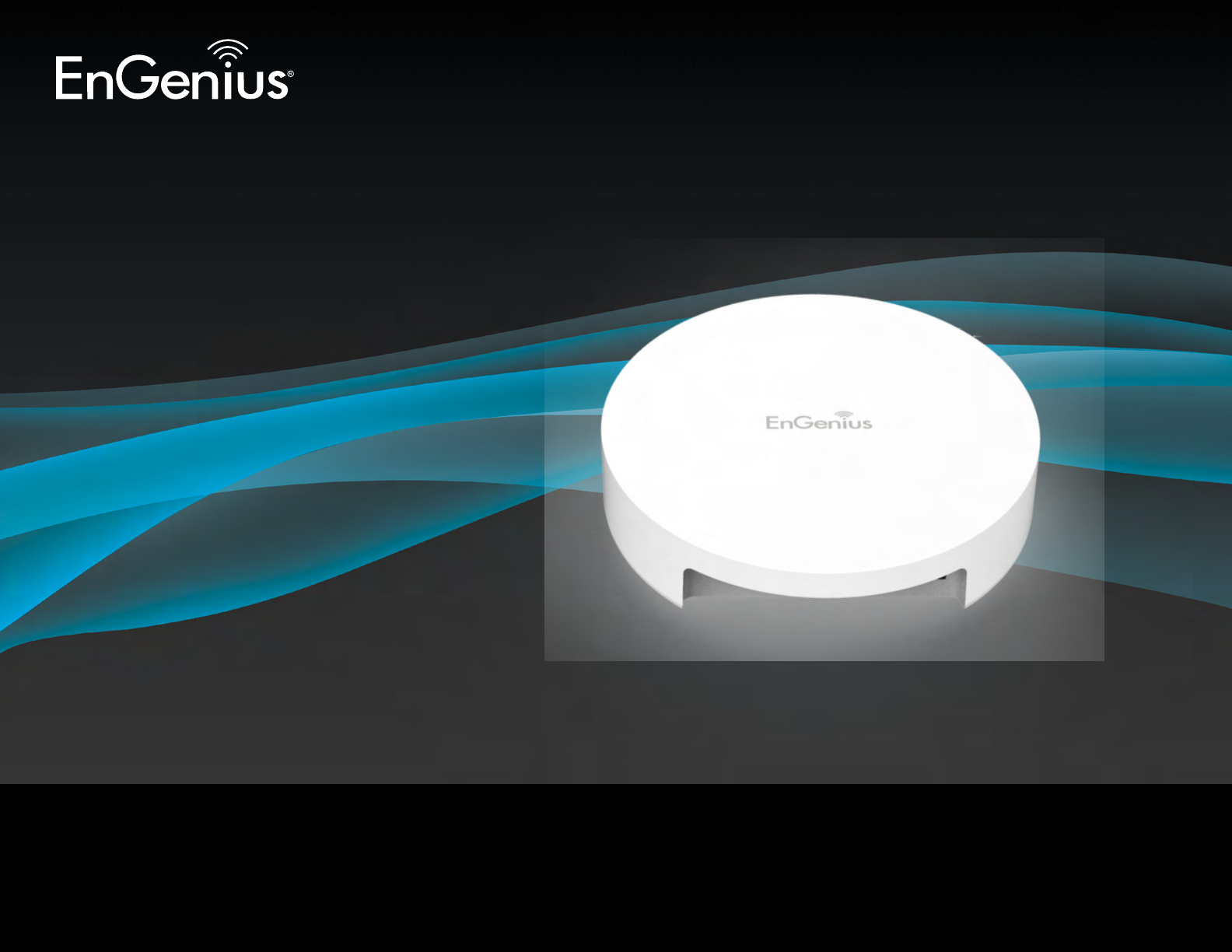
User Manual
Business Solutions
Dual Band Indoor Ceiing Mount Access Point
EAP 11AC Series
version 1.3
2
IMPORTANT
To install this Access Point please refer to the
Quick Installation Guide included in the product packaging.
3
Chapter 1 Product Overview................................................... 4
Key Features/Introduction........................................................... 5
System Requirements / Package Contents .............................. 6
TechnicalSpecications...............................................................9
Physical Interface........................................................................... 12
Chapter 2 Before You Begin .................................................. 14
Computer Settings....................................................................... 15
Mounting the Access Point........................................................... 20
Chapter 3 Conguring Your Access Point.......................... 23
Default Settings............................................................................ 24
Chapter 4 Building a Wireless Network............................. 25
Access Point Mode....................................................................... 26
WDS AP Mode............................................................................... 27
WDS Bridge Mode........................................................................ 28
Chapter 5 Overview............................................................... 29
Overview........................................................................................... 30
Connections.................................................................................... 31
Chapter 6 Network ................................................................. 32
Operation Mode/Basic................................................................. 33
IP Settings/SpanningTree Settings..................................... 34
Chapter 7 2.4 GHz & 5 GHz Wireless................................... 36
Wireless Settings........................................................................ 39
2.4 GHz/5 GHz Wireless Network........................................... 40
2.4GHz/5GHzSSIDProle......................................................42
Wireless Security.......................................................................... 43
Wireless MAC Filtering............................................................... 46
Wireless Advanced..................................................................... 47
WDSLinkSettings....................................................................... 49
Guest Network Settings............................................................ 50
Chapter 8 Management........................................................ 49
Management VLAN Settings.................................................. 51
Advanced Settings....................................................................... 54
Time Zone........................................................................................ 55
Auto Reboot Settings................................................................ 58
Wi-FiScheduler...............................................................................59
Tools.................................................................................................. 60
Account/Firmware........................................................................ 61
Backup/Restore ............................................................................. 64
Log.................................................................................................... 65
Logout/Reset................................................................................. 67
Appendix ................................................................................. 68
FCC Interference Statement.................................................. 69
IC Interference Statement.................................................... 70
CE Interference Statement..................................................... 72
Detachable Antenna Usage.................................................... 73
Table of Contents
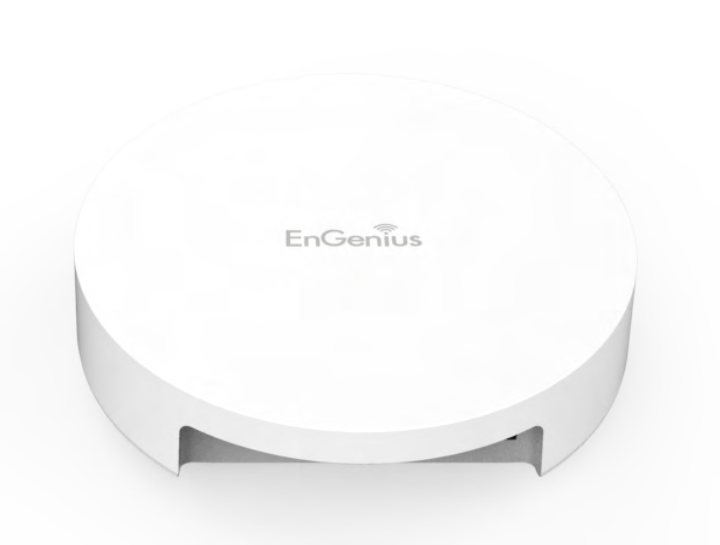
4
Chapter 1
Product Overview
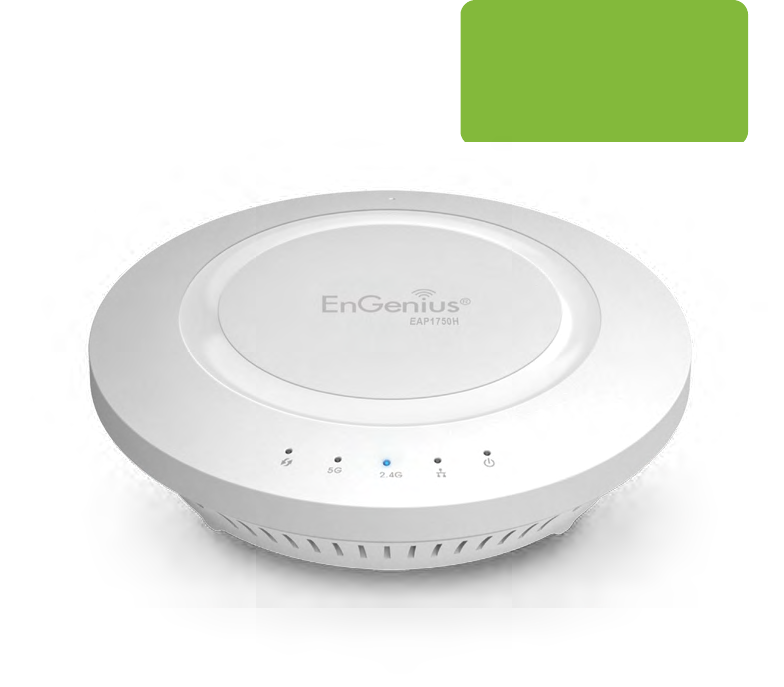
5
Maximum data rates are based on IEEE 802.11 standards. Actual throughput and range may vary depending on many factors including environmental conditions, distance between
devices, radio interference in the operating environment, and mix of devices in the network. Features and specications subject to change without notice. Trademarks and registered
trademarks are the property of their respective owners. For United States of America: Copyright © 2017 EnGenius Technologies, Inc. All rights reserved.
Key Features
• Hightransmitpower,enablinglongrangeconnectivity
• SupportsIEEE802.11ac/b/g/nwirelessstandardswithupto450
Mbps data rate on 2.4GHz and 1300Mbps data rate on 5GHz
• Threeinternal5dBi(2.4GHz)andthree5dBi(5GHz)omni-directional
MIMO antennas
• CanbemonitoredafterdeploymentwithEnGeniusEZ
Controller™ software for Windows
(Freeonlinedownload)
• CanbeusedwithincludedpoweradapterorviaPoEwithPoE
802.3at - capable Switches or Injectors
• DualBand/ThreeStream
• AdvancedTrafcshapingcanbeassisteduserstocontrolupload/
download wirelss speed per SSID
• BandSteeringshiftsdualbandclientstothe5GHzbandfortorelieve
network congestion on the 2.4 GHz band
• SecuredGuestNetwork
Introduction
The EAP1750H leverages the breakthrough speed and
performance 802.11ac for connecting to laptops and other
devices that need to wirelessly stream HD video or transfer
large les. The EAP1750H is an 802.11ac 3x3 Indoor
Access Point. This high-powered ceiling mount Dual Band
Access Point features speeds up to 450 Mbps on 2.4 GHz
and up to 1300 Mbps on the 5 GHz band when associated
Introduction - EAP1750H
can be used with
802.3at
capable switches or injectors
withACclientdevices.ItcanbeconguredasanAccess
Point,RepeaterandWDS(AP&Bridge)andfeaturesahigh
transmit RF power of 28 dBm transmit RF power on the 2.4
GHz band and 28 dBm on the 5 GHz band for long range
connectivity. The EAP1750H includes a Gigabit Ethernet
port for connecting to 802.3at-capable PoE Switches and
anenhancedreceivesensitivityMIMO(MultipleIn/Multiple
6
Out)integratedsectorized3Dantennaarray.It’sanideal
solution for spacious interior environments such as large
homes,smallandmedium-sizedbusinesses,multiple-oor
buildings,hotels,hospitals,andothervenues.
System Requirements
The following are the Minimum System Requirements in
ordercongurethedevice:
• ComputerwithanEthernetinterfaceorwirelessnetwork
capability
• WindowsOS(7,8,10),MacOS,orLinux-basedoperating
systems
• Web-BrowsingApplication(i.e.:Edge,InternetExplorer,Firefox,
Chrome,Safari,oranothersimilarbrowserapplication)
Package Contents
The EAP1750H/EAP1300 package contains the following
items(allitemsmustbeinpackagetoissuearefund):
• OneAccessPoint
• 12VPowerAdapter
• RJ-45EthernetCable
• QuickInstallationGuide
• CeilingandWallMountScrewkit
• T-RailMountingkit
• MountingBracket
The EAP1250 package contains the following items (all
itemsmustbeinpackagetoissuearefund):
• OneAccessPoint
• 12VPowerAdapter
• QuickInstallationGuide
• WallMountscrewset
• T-RailMountingkit(9/16”and15/16”)
* The 3-Pack package is provided the optional adapter for purchasing.
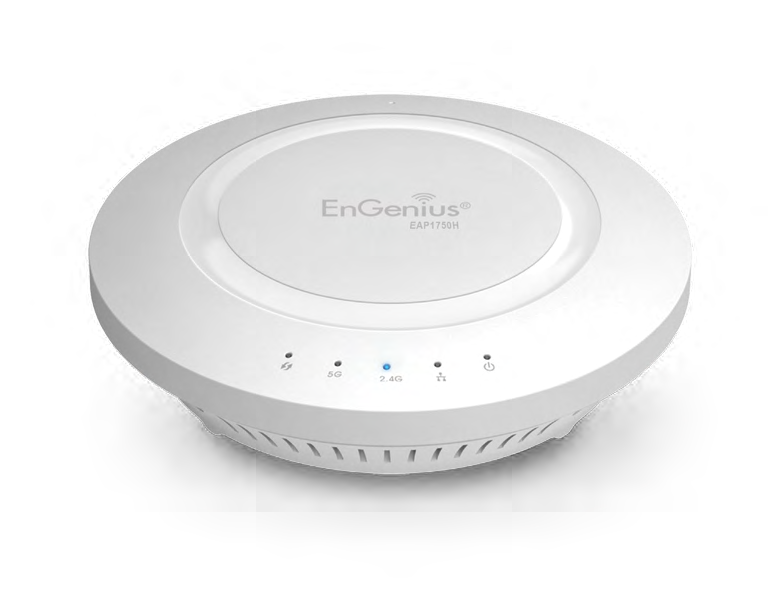
7
Maximum data rates are based on IEEE 802.11 standards. Actual throughput and range may vary depending on many factors including environmental conditions, distance between
devices, radio interference in the operating environment, and mix of devices in the network. Features and specications subject to change without notice. Trademarks and registered
trademarks are the property of their respective owners. For United States of America: Copyright © 2017 EnGenius Technologies, Inc. All rights reserved.
Key Features
• Hightransmitpower,enablinglongrangeconnectivity
• SupportsIEEE802.11acwave2/b/g/nwirelessstandardswithupto400
Mbps data rate on 2.4GHz and 867Mbps data rate on 5GHz
• Twointernal4dBi(2.4GHz)andtwo5dBi(5GHz)omni-directional
MIMOantennas(EAP1300)
• TwoRP-SMA6dBi(2.4GHz)andtwoRP-SMA5dBi(5GHz)omni-
directionalMIMOantennas(EAP1300EXT)
• SupportWave2MU-MIMOfunctionon5GHzradio.
• SupportTxBeamformingtoenlargethetransmittingdistance.
• CanbemonitoredafterdeploymentwithEnGeniusezMasterfrom
local side and remote end side easil.
• CanbeusedwithincludedpoweradapterorviaPoEwithPoE
802.3af/at - capable Switches or Injectors
• AdvancedTrafcshapingcanbeassisteduserstocontrolupload/
download wirelss speed per SSID / per user
• BandSteeringshiftsdualbandclientstothe5GHzbandfortorelieve
network congestion on the 2.4 GHz band
• SecuredGuestNetworkoptionavailable
Introduction
The AP is 802.11 ac wave2/a/b/g/n Outdoor Access Point
with speeds up to 400 Mbps on 2.4GHz and 867Mbps
on 5GHz band. It can be congured as an Access Point,
Repeater or WDS (AP, Station & Bridge). The AP is an
affordable solution which is built in high-powered radios
Introduction - EAP1300 (EXT)
and long-range settings to replace the ordinary Access
Points that do not have the range and reach to connect to
agrowingnumberofwirelessusers.WithWave2features,
the Access Point could reduce the handling period on client
devices and network with more client devices at the same
time.
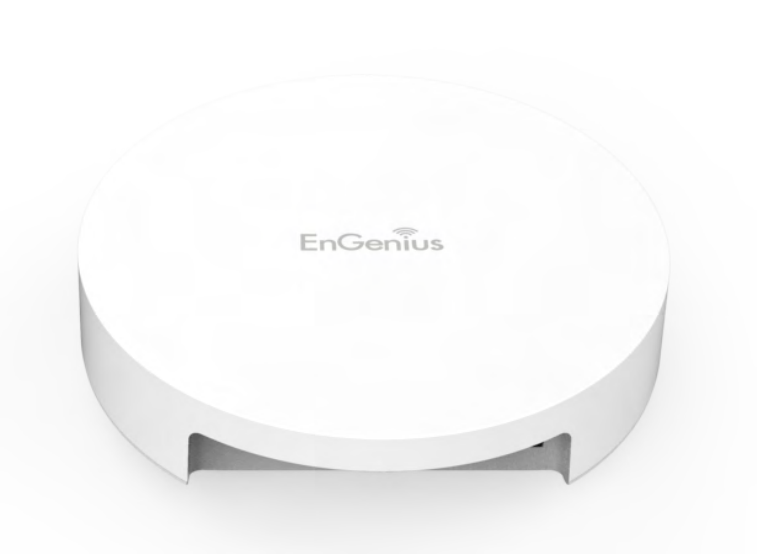
8
Maximum data rates are based on IEEE 802.11 standards. Actual throughput and range may vary depending on many factors including environmental conditions, distance between
devices, radio interference in the operating environment, and mix of devices in the network. Features and specications subject to change without notice. Trademarks and registered
trademarks are the property of their respective owners. For United States of America: Copyright © 2017 EnGenius Technologies, Inc. All rights reserved.
Key Features
• Hightransmitpower,enablinglongrangeconnectivity
• SupportsIEEE802.11acwave2/b/g/nwirelessstandardswithupto400
Mbps data rate on 2.4GHz and 867Mbps data rate on 5GHz
• SupportWave2MU-MIMOfunctionon5GHzradio.
• SupportTxBeamformingtoenlargethetransmittingdistance.
• CanbemonitoredafterdeploymentwithEnGeniusezMasterfrom
local side and remote end side easil.
• CanbeusedwithincludedpoweradapterorviaPoEwithPoE
802.3af/at - capable Switches or Injectors
• AdvancedTrafcshapingcanbeassisteduserstocontrolupload/
download wirelss speed per SSID / per user
• BandSteeringshiftsdualbandclientstothe5GHzbandfortorelieve
network congestion on the 2.4 GHz band
• SecuredGuestNetworkoptionavailable
Introduction
The AP is 802.11 ac wave2/a/b/g/n Outdoor Access Point
with speeds up to 400 Mbps on 2.4GHz and 867Mbps on
5GHzband.ItcanbeconguredasanAccessPoint,orWDS
(AP, Station & Bridge). The AP is an affordable solution
which is built in high-powered radios and long-range
settings to replace the ordinary Access Points that do not
have the range and reach to connect to a growing number
ofwirelessusers.WithWave2features,theAccessPoint
Introduction - EAP1250
could reduce the handling period on client devices and
network with more client devices at the same time.
9
L2 Isolation
802.1XAuthenticator(MD5/TLS/TTLS/PEAP)
Guest Network
QoS (Quality of Service)
WMM(WirelessMultimedia)
Wireless Management
Webinterface(HTTP/HTTPS)
SNMP v1/v2c/v3 with MIB I/II and private MIB
CLI(Telnet/SSH)
Firmware Upgrade
Backup/Restore Settings
SaveCongurationasDefault
Auto Reboot
E-mailAlert/SyslogNotication
Physical Security
Kensington Security Slot
Physical/Environment Conditions
Operating:
Temperature:32°Fto104°F(0°Cto40°C)
Humidity(Non-condensing):90%orless
Storage:
Temperature:-4°Fto140°F(-20°Cto60°C)
Humidity(Non-condensing):90%orless
Standard:
IEEE802.11b/g/n on 2.4 GHz
IEEE 802.11ac/a/n on 5 GHz
IEEE802.3at
Physical Interface
1x10/100/1000GigabitEthernetPort
1xResetButton
1xPowerConnector
LED Indicator
Power
WPS
WLAN(WirelessConnection)
LAN
Power Requirements
ExternalPowerAdapter
DCIN,12V/2A
ActiveEthernet(Power-over-Ethernet)
802.3at PoE Input
Operation Modes
Access Point
WDS AP
WDS Bridge
Repeater (Available in December, 2017)
Security
WEP(64/128bit)
WPA/WPA2(TKIP/AES)
Hidden SSID
MACaddressltering,upto32eldsperSSID
Technical Specications - EAP1750H
10
MACaddressltering,upto32eldsperSSID
L2 Isolation
802.1XAuthenticator(MD5/TLS/TTLS/PEAP)
Guest Network
QoS (Quality of Service)
WMM(WirelessMultimedia)
Wireless Management
Webinterface(HTTP/HTTPS)
SNMP v1/v2c/v3 with MIB I/II and private MIB
CLI(Telnet/SSH)
Firmware Upgrade
Backup/Restore Settings
SaveCongurationasDefault
Auto Reboot
E-mailAlert/SyslogNotication
Physical/Environment Conditions
Operating:
Temperature:32°Fto104°F(0°Cto40°C)
Humidity(Non-condensing):90%orless
Storage:
Temperature:-4°Fto140°F(-20°Cto60°C)
Humidity(Non-condensing):90%orless
Standard:
IEEE802.11b/g/n on 2.4 GHz
IEEE 802.11ac/a/n on 5 GHz
IEEE802.3af
Physical Interface
1x10/100/1000GigabitEthernetPort
1xResetButton
1xPowerConnector
LED Indicator
Power
WPS
WLAN(WirelessConnection)
LAN
Power Requirements
ExternalPowerAdapter
DCIN,12V/1A
ActiveEthernet(Power-over-Ethernet)
802.3af/at PoE Input
Operation Modes
Access Point
WDS AP
WDS Bridge
Repeater (Available in December, 2017)
Security
WEP(64/128bit)
WPA/WPA2(TKIP/AES)
Hidden SSID
Technical Specications - EAP1300(EXT)
11
Wireless Management
Webinterface(HTTP/HTTPS)
SNMP v1/v2c/v3 with MIB I/II and private MIB
CLI(Telnet/SSH)
Firmware Upgrade
Backup/Restore Settings
SaveCongurationasDefault
Auto Reboot
E-mailAlert/SyslogNotication
Physical/Environment Conditions
Operating:
Temperature:32°Fto104°F(0°Cto40°C)
Humidity(Non-condensing):90%orless
Storage:
Temperature:-4°Fto140°F(-20°Cto60°C)
Humidity(Non-condensing):90%orless
Standard:
IEEE802.11b/g/n on 2.4 GHz
IEEE 802.11ac/a/n on 5 GHz
IEEE802.3af
Physical Interface
1x10/100/1000GigabitEthernetPort
1xResetButton
1xPowerConnector
LED Indicator
Power Requirements
ExternalPowerAdapter
DCIN,12V/1A
ActiveEthernet(Power-over-Ethernet)
802.3af/at PoE Input
Operation Modes
Access Point
WDS AP
WDS Bridge
Security
WEP(64/128bit)
WPA/WPA2(TKIP/AES)
Hidden SSID
MACaddressltering,upto32eldsperSSID
L2 Isolation
802.1XAuthenticator(MD5/TLS/TTLS/PEAP)
Guest Network
QoS (Quality of Service)
WMM(WirelessMultimedia)
Technical Specications - EAP1250
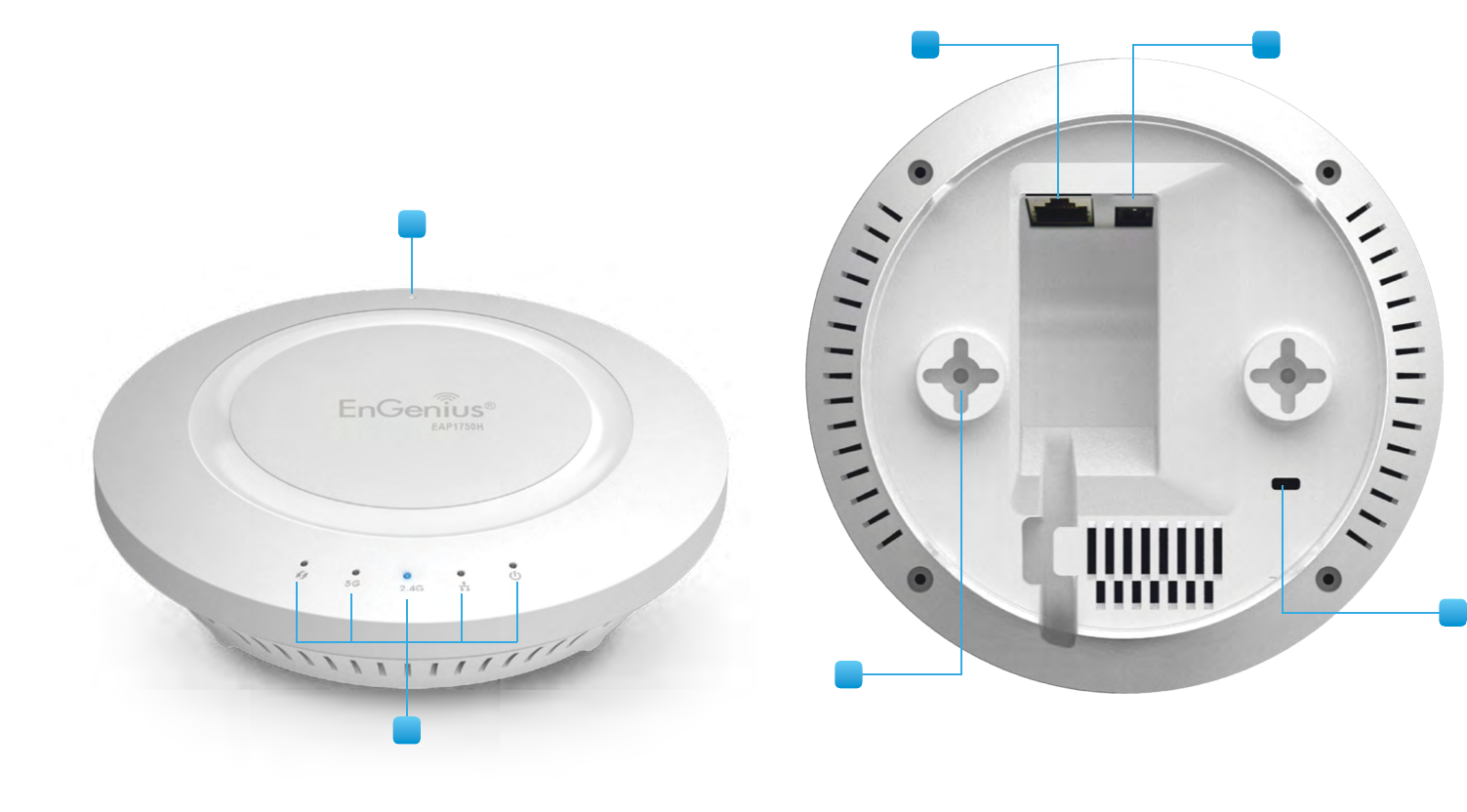
12
Physical Interface (EAP1750H/EAP1300(EXT))
Dimensions and Weights
Diameter:6.36”
Height:1.64”
Weight:0.65lbs.
1 Reset Button: Press and hold for over 10 seconds to reset to
factory default settings.
2 LED Indicators: LEDlightsforWPS,WLAN5GHz,WLAN2.4GHz,
Ethernetport,andPower
3 LAN Port (PoE): EthernetportforRJ-45cable.
4 Power Connector: 12V DC IN for Power.
5 Ceiling (Wall) Mount Hole: Using the provided hardware, the
EAP AP can be attached to a ceiling or wall.
6 Kensington Security Slot: ToprotectyourEAP1750H,usethe
Kensington Security Slot to attach a cable lock*.(EAP1750H
Only)
*cable lock not included
3 4
1
2
5
6
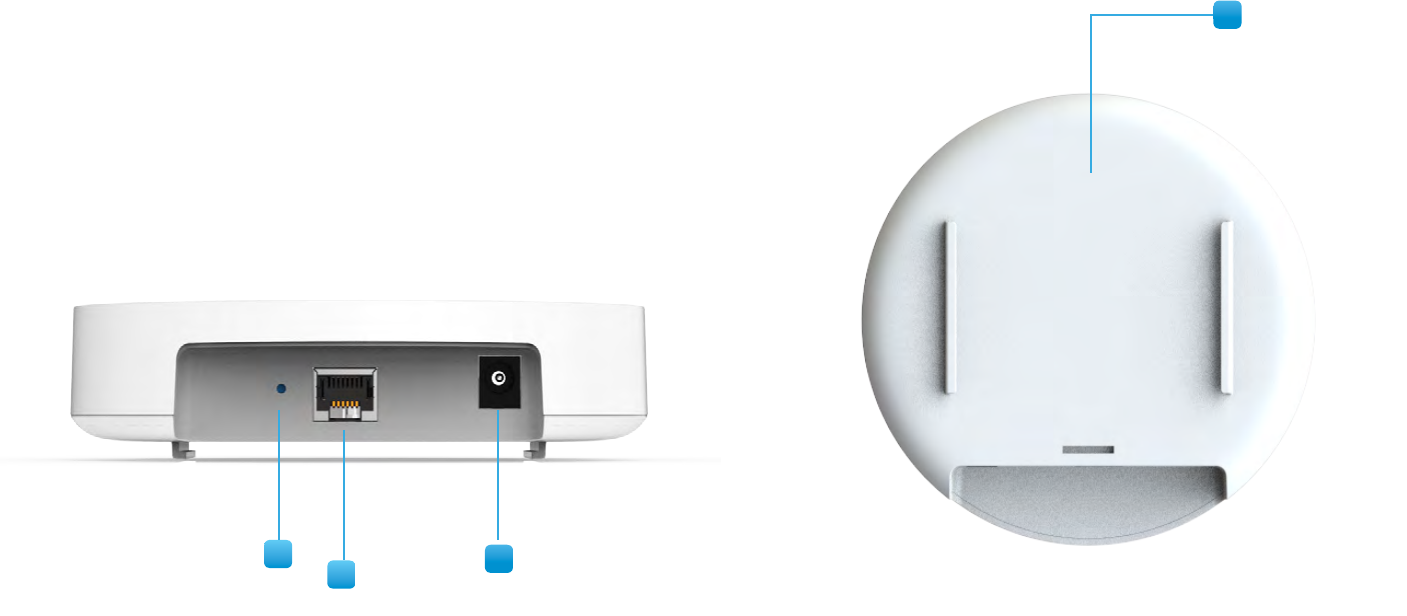
13
Physical Interface (EAP1250)
Dimensions and Weights
Diameter:132.4mm(5.22”)
Height:37.4mm(1.47”)
Weight:220g(0.49lbs.)
1 Reset Button: Press and hold for over 10 seconds to reset to
factory default settings.
2 LAN Port (PoE): EthernetportforRJ-45cable.
3 Power Connector: 12V DC IN for Power.
4 Ceiling (Wall) Mount Hole: Using the provided hardware, the
EAP AP can be attached to a ceiling or wall.
3
4
1
2
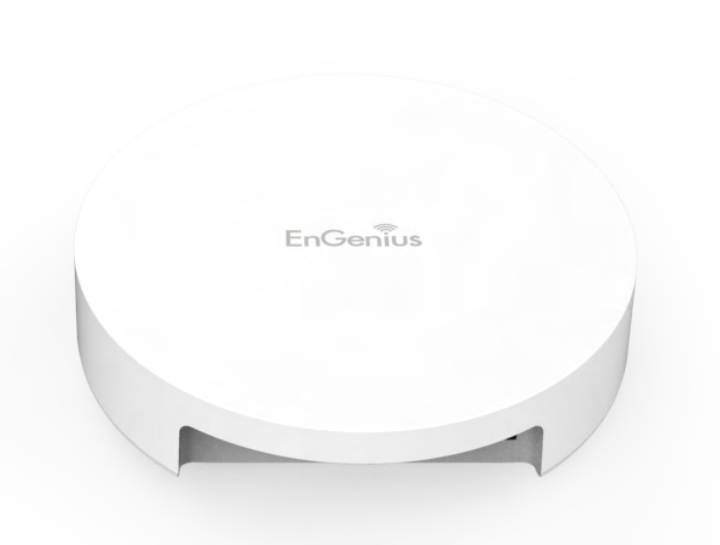
14
Chapter 2
Before You Begin

15
Windows XP/Windows 7/Windows 8/Windows
10
InordertousetheAccessPoint,youmustrstcongurethe
TCP/IPv4 connection of your Windows OS computer system.
1a. Click the Start button and open the Control Panel
1b. Move your mouse to the lower right hot corner to
display the Charms Bar and select the Control Panel in
Windows 8 OS.
1c. In Windows 10, click Start to select All APPs to enter
the folder of Windows system for selecting Control
Panel.
Computer Settings
Windows XP Windows 7
Windows 8
Windows 10

16
2a. In Windows XP, click Network Connections.
2b. In Windows 7/Windows 8/Windows 10, click View
Network Status and Tasks in the Network and
Internetsection,thenselect Change adapter settings.
3. Right click on Local Area Connection and select Properties.
4. Select Internet Protocol Version 4 (TCP/IPv4) and then
select Properties.
5. Select Use the following IP address and enter an IP
address that is different from the Access Point and Subnet
mask,thenclickOK.
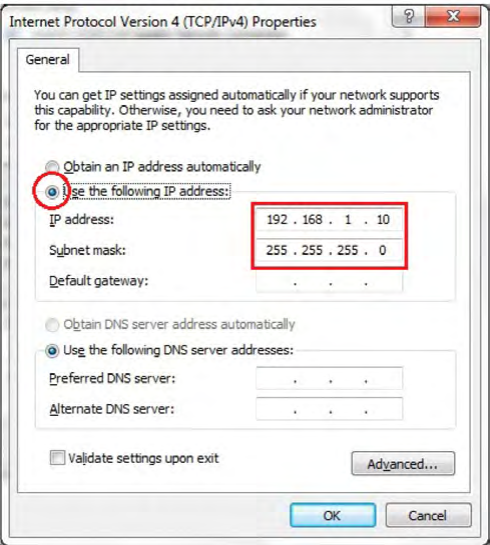
17
Note: Ensure that the IP address and Subnet mask are
on the same subnet as the device.
Forexample:APIPaddress:192.168.1.1
PCIPaddress:192.168.1.2–192.168.1.255
PCSubnetmask:255.255.255.0
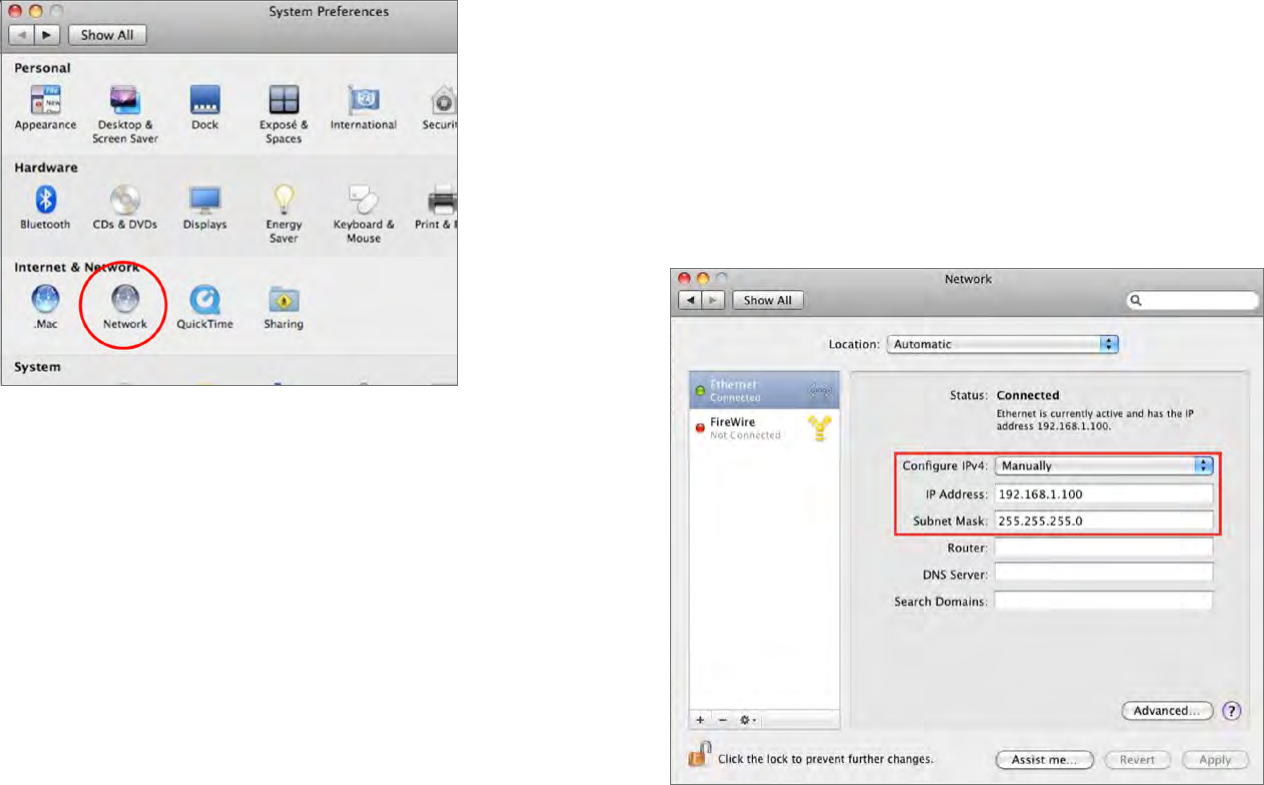
18
Apple Mac OS X
1. Go to System Preferences(Whichcanbeopenedinthe
ApplicationsfolderorselectingitintheAppleMenu).
2. Select Network in the Internet & Network section.
3. Highlight Ethernet.
4. In Congure IPv4,selectManually.
5. Enter an IP address that is different from the Access
Point and Subnet mask then press OK.
Note: Ensure that the IP address and Subnet mask are
on the same subnet as the device.
Forexample:AdeviceIPaddress:192.168.1.1
PCIPaddress:192.168.1.2–192.168.1.255
PCSubnetmask:255.255.255.0
6. Click Apply when done.
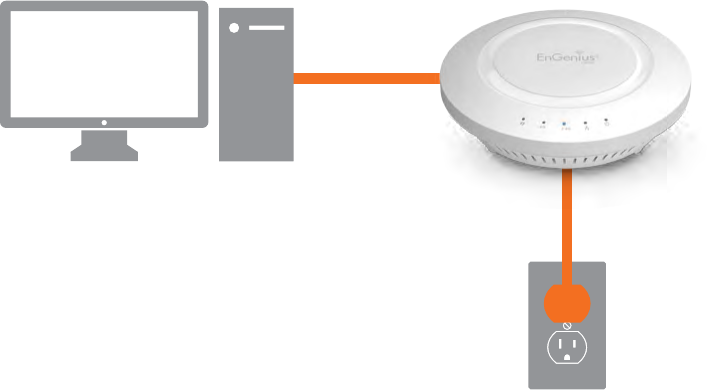
19
1. Ensure that the computer in use has an Ethernet
Controller port (RJ-45 Ethernet Port). For more
information,verifywithyourcomputer’susermanual.
2. Connect one end of the Category 5e Ethernet cable into
theRJ-45portoftheEAP1750Handtheotherendto
theRJ-45portofthecomputer.Ensurethatthecable
is securely connected to both the EAP1750H and the
computer.
3. Connect the Power Adapter DC connector to the DC-IN
port of the EAP1750H and the Power Adapter to an
available electrical outlet. Once both connections are
secure,verifythefollowing:
a)EnsurethatthePOWERlightison(itwillbeorange).
b)Ensurethatthe2.4GHz/5GHzWLANlightison(itwill
be bluefor2.4G,andgreenfor5G).
c) EnsuregthatgthehLANg(ComputergEAP1750HgConnection)
lightison(itwillbeblue).
d)Once all three lights are on, proceed to set up the
Access Point using the computer.
Thisdiagramdepictsthehardwareconguration.
Hardware Installation
Ethernet
PC
Power
Outlet
AC/DC
Cable
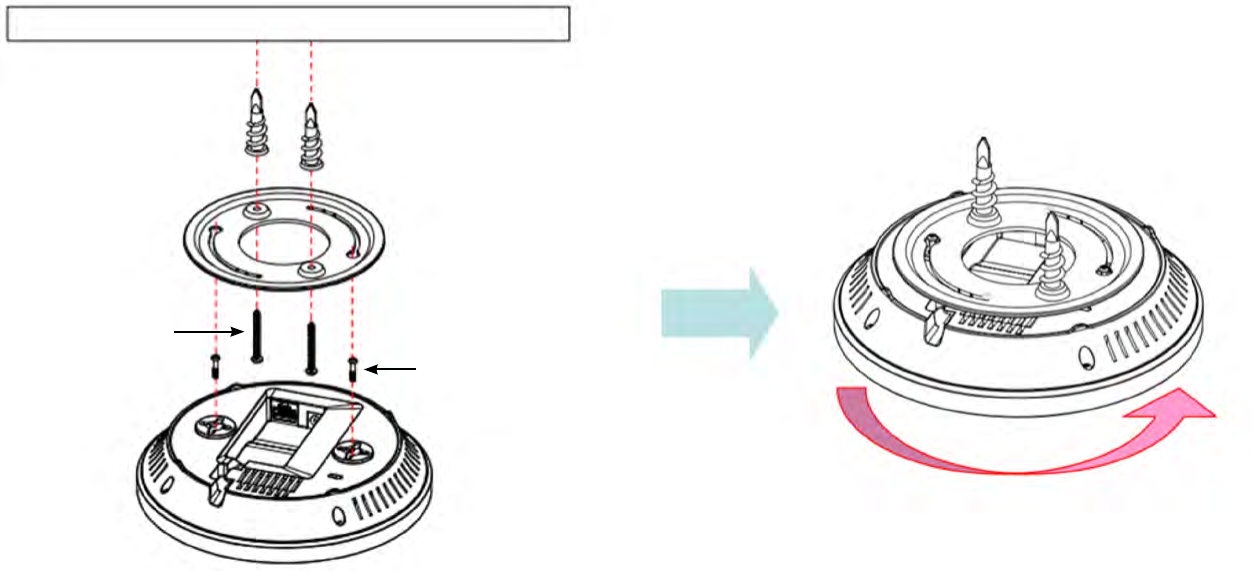
20
Using the provided hardware, the EAP1750H/EAP1300
can be attached to a ceiling or wall.
To attach the EAP AP to a ceiling or wall using
the mounting bracket:
1. Attach the mounting bracket to the wall or ceiling using
the provided wall/ceiling mounting hardware kit.
2. Insert the provided short screws into the bottom cover
of the EAP.
Leaveenoughofthescrewsexposedtoensurethatthe
unit can be attached to the mounting bracket.
Ifextraspaceisrequired,usetheprovidedspacersandlong
screws from the T-Rail mounting hardware kit to increase
the space between the unit and the mounting bracket.
3. Mount the EAP on the mounting bracket by rotating the
unitclockwiseabout90degreestosecureitinplace.
Mounting the EAP1750H / EAP1300(EXT)
Wall
Mounting Screw
Lock the EAP1750H by revolving
Mounting Bracket
P2.6*12 Screw
P3.5*32 Screw
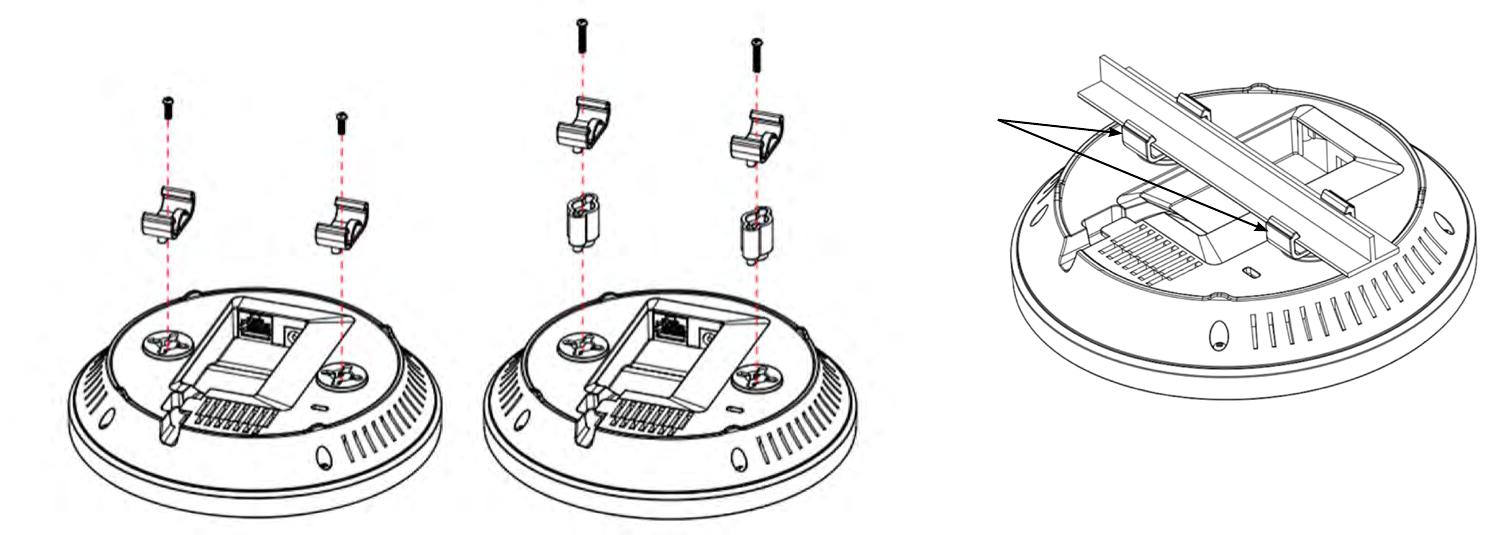
21
Attaching the EAP1750H/EAP1300 to a ceiling
using the provided T-Rail connectors:
1. Attach the T-Rail connectors to the bottom cover of the
EAP using the provided short screws.
Note: Two sizes of T-Rail connectors are included in the
mounting hardware kit: 15/16in (2.38cm) and 9/16in
(1.43cm).Ifextraspaceisrequiredtoaccommodatedrop
ceilingtiles,usetheprovidedspacersandlongscrews.
2. Line up the connected T-Rail connectors with an
appropriately sized rail and press the unit onto the rail
until it snaps into place.
Note: ToprotectyourEAP,usetheKensingtonSecurity
Slottoattachacablelock(cablelockisnotincluded).
P2.6*10 Screw
Clip
T-Rail
Clip Clips
Spacer
P2.6*25 Screw
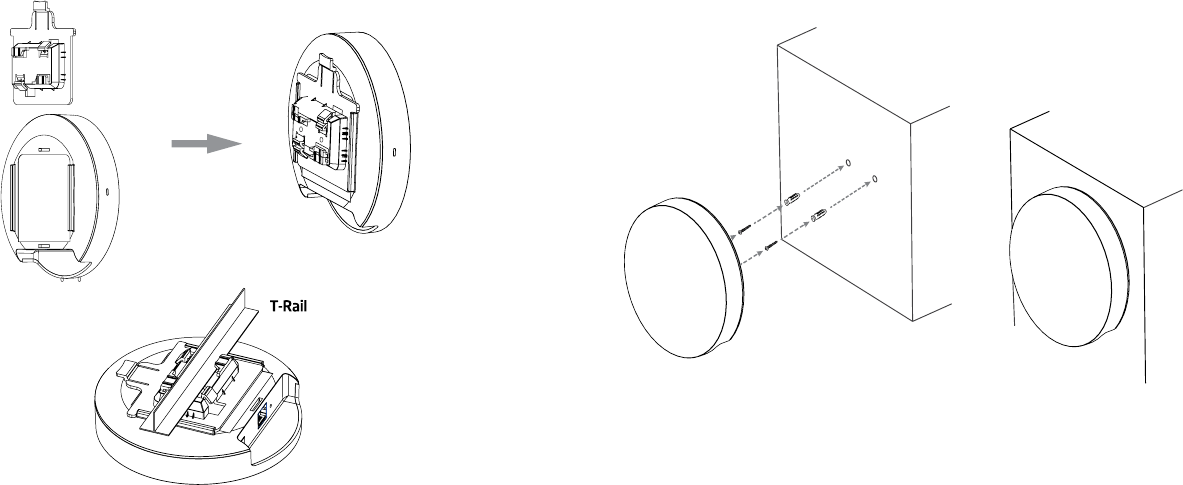
22
Attaching the EAP1250 to a ceiling :
1. Slide the ceiling mount base into the slot of this Access
Point.
2. Hold the Access Point with one hand to reach the other
hand over the T-rail side of the bracket. Then hook the
stationary end of the ceiling mount bracket on to the
T-rail.
Attaching the EAP1250 to a wall :
3. ContinuefromA,determinethewheretheAccessPoint
to be placed and mark location on the surface for the
two mounting holes. Use the appropriate drill bit to
drill two 8.1mm diagram and 26mm depth holes in the
markings and hammer the bolts into the openings.
4.Screwtheanchorsuntotheholesuntiltheyareush
with the wall; screw the included screw into the achors.
5. Place the Access point against the wall with the
mounting screw heads
Note: Mounting hardware kit are included 15/16in
(2.38cm)and9/16in(1.43cm).Ifextraspaceisrequired
to accommodate drop ceiling tiles, use the provided
spacers and long screws.
12
3
4
5
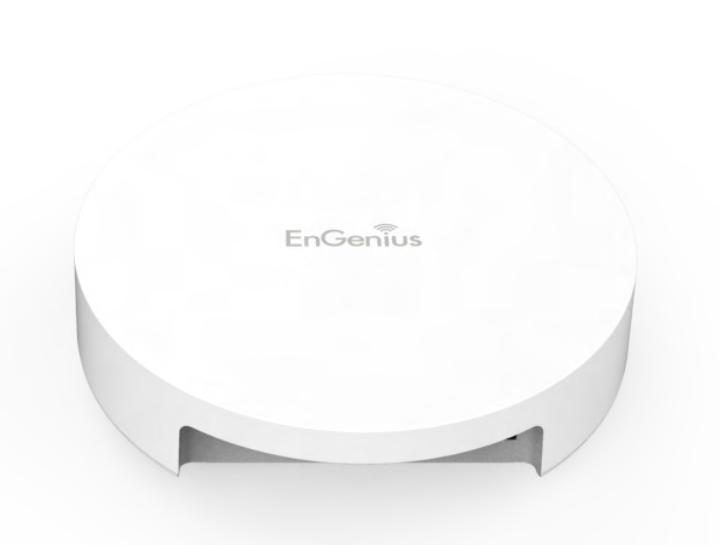
23
Chapter 3
Conguring Your Access Point
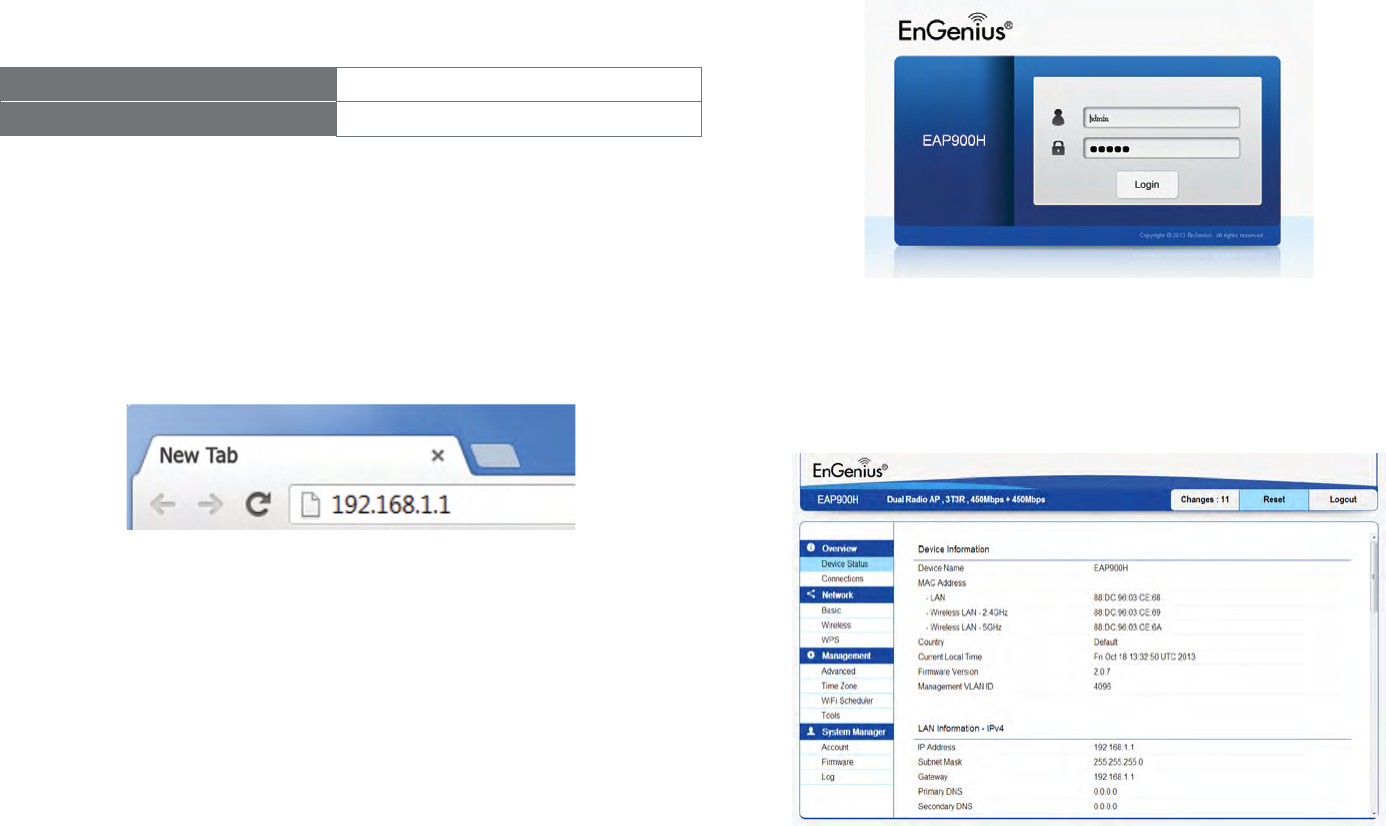
24
This section will show you how to congure the device
usingtheweb-basedcongurationinterface.
Default Settings
Please use your Ethernet port or wireless network adapter
to connect the Access Point.
IP Address 192.168.1.1
Username/Password admin/admin
Web Conguration
1. Openawebbrowser(InternetExplorer/Firefox/Safari)
and enter the IP Address http://192.168.1.1.
Note: If you have changed the default LAN IP Address of
theAccessPoint,ensureyouenterthecorrectIPAddress.
2. Thedefaultusernameandpasswordare:admin. Once
youhaveenteredthecorrectusernameandpassword,
click the Login button to open the web-based
congurationpage.
* The model name will be varied in the web browser.
3. If successful, you will be logged in and see the EAP
User Menu.
Conguring Your Access Point
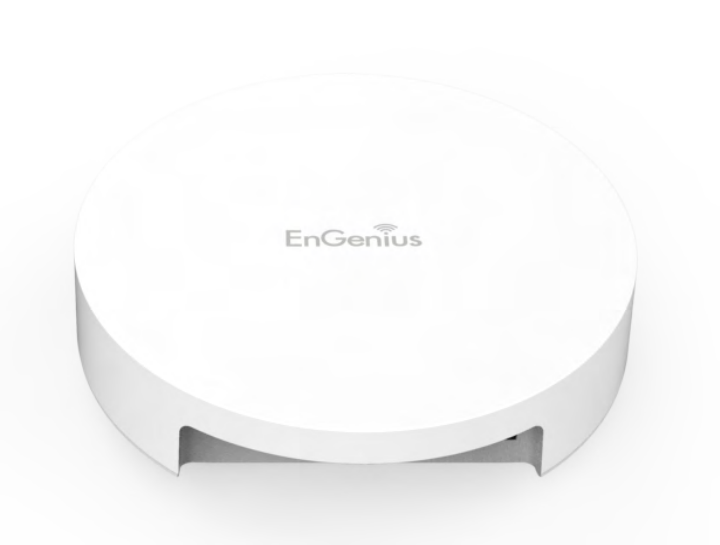
25
Chapter 4
Building a Wireless Network
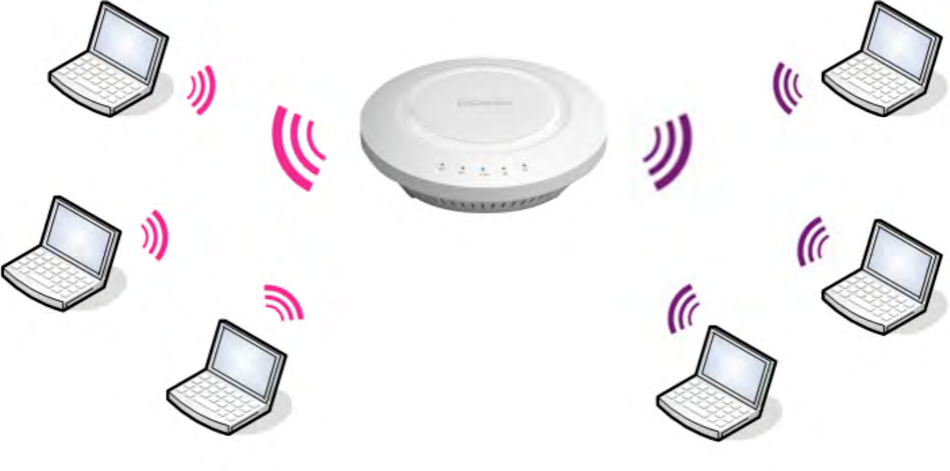
26
The EAP1750H has the ability to operate in various modes. This chapter describes the operating modes of the EAP1750H.
Access Point Mode
InAccessPointMode,theEAP1750HbehaveslikeacentralconnectionforstationsorclientsthatsupportIEEE802.11a/b/g/n
networks.ThestationsandclientsmustbeconguredtousethesameSSID(ServiceSetIdentier)andsecuritypasswordto
associatewiththeEAP1750H.TheEAP1750Hsupportsuptoeight(8)SSIDsperband(16total)atthesametimeforsecure
access.
EAP 1750H
AP/AP
Client
Client
Client Client
Client
Client
2.4 GHz 5 GHz

27
WDS AP Mode
The EAP1750H also supports WDS AP mode. This operating mode allows wireless connections to the EAP1750H using
WDStechnology.Inthismode,conguretheMACaddressesinbothAccessPointstoenlargethewirelessareabyenabling
WDSLinksettings.WDSsupportsuptofour(4)APMACaddresses.
EAP1750H
WDS AP
EAP1750H
WDS AP
2.4 GHz 2.4 GHz
5 GHz 5 GHz
Client
Client Client
Client
Client
Computer
Client
Computer
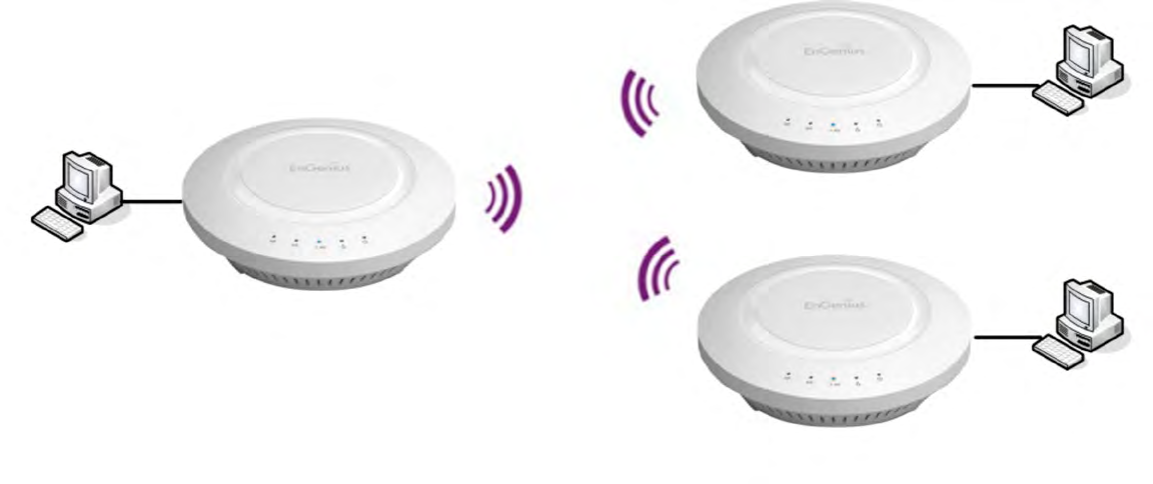
28
WDS Bridge Mode
InWDSBridgeMode,theEAP1750HcanwirelesslyconnectdifferentLANsbyconguringtheMACaddressandsecurity
settings of each EAP1750H device. Use this mode when two wired LANs located a small distance apart want to communicate
witheachother.ThebestsolutionistousetheEAP1750HtowirelesslyconnecttwowiredLANs,asshowninthefollowing
gure.WDSBridgeModecanestablishuptofour(4)WDSlinks,creatingastar-likenetwork.
Note: WDS Bridge Mode does not act as an Access Point because Access Points linked by WDS use the same frequency
channel.MoreAccessPointsconnectedtogethermaylowerthroughput.Thiscongurationcanalsobesusceptibleto
generateendlessnetworkloopsinyournetwork,soitisrecommendedtoenabletheSpanningTreefeaturetoprevent
thisfromhappening.YoucanndinformationabouttheSpanningTreeFunctiononpage29.
EAP1750H
WDS Bridge
EAP1750H
WDS Bridge
EAP1750H
WDS Bridge
Client
Computer
Client
Computer
Client
Computer
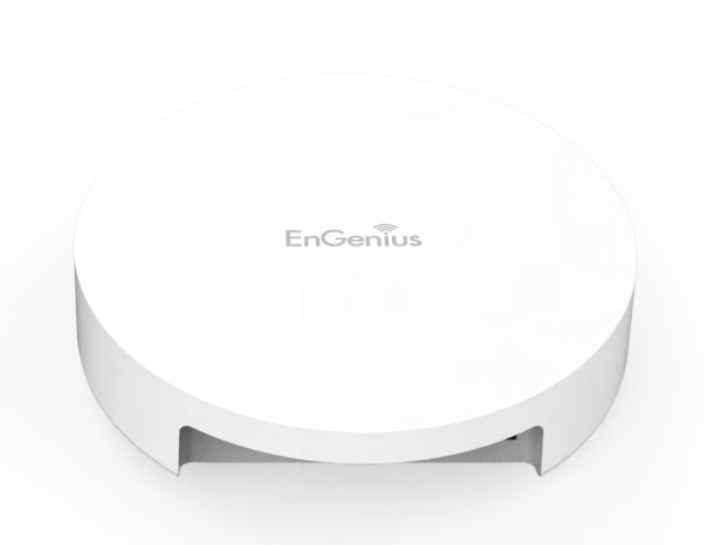
29
Chapter 5
Overview
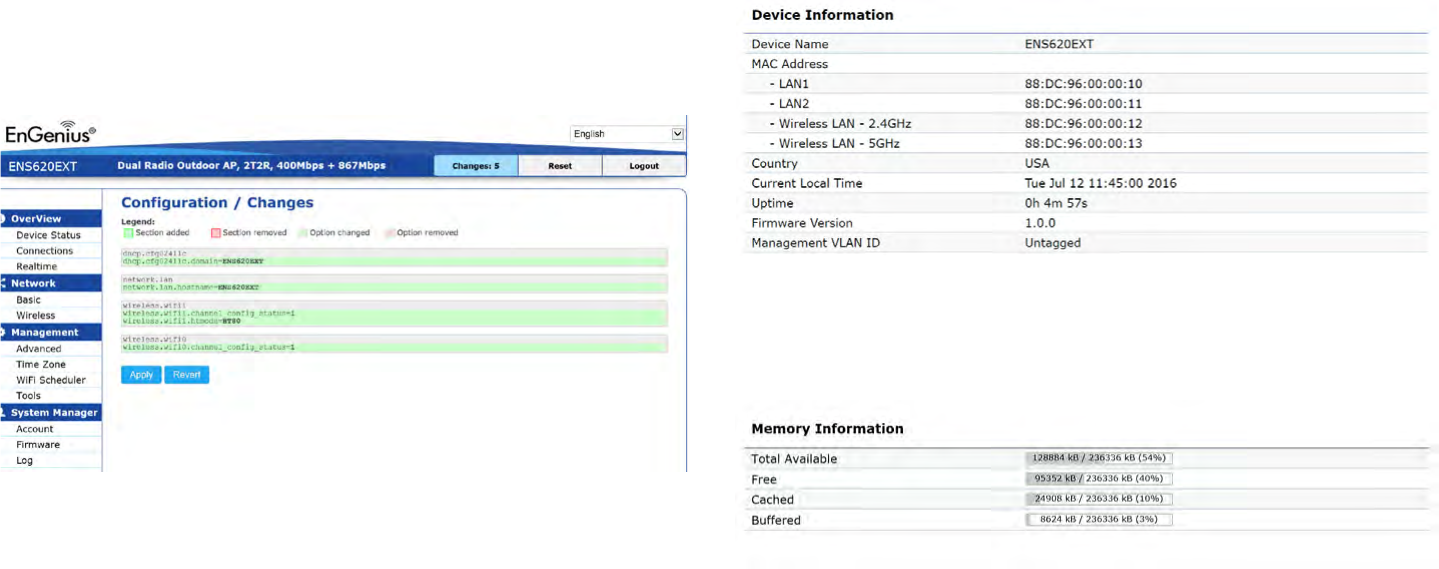
30
Save Changes
This page lets you save and apply the settings shown under
Unsaved changes list,orReverttheunsavedchangesand
revert to the previous settings that were in effect.
Device Status
Clicking the Device Status link under the Overview menu
shows the status information about the current operating
mode.
• The Device Information section shows general system
informationsuchasDeviceName,MACAddress,Current
Time,FirmwareVersion,andManagementVLANID
Note: VLANIDisonlyapplicableinAccessPoint,WDS
AP or WDS BR mode.
• The Memory Information section shows usage of
memorysuchasTotalAvailable,Free,Cached,Buffered
Overview
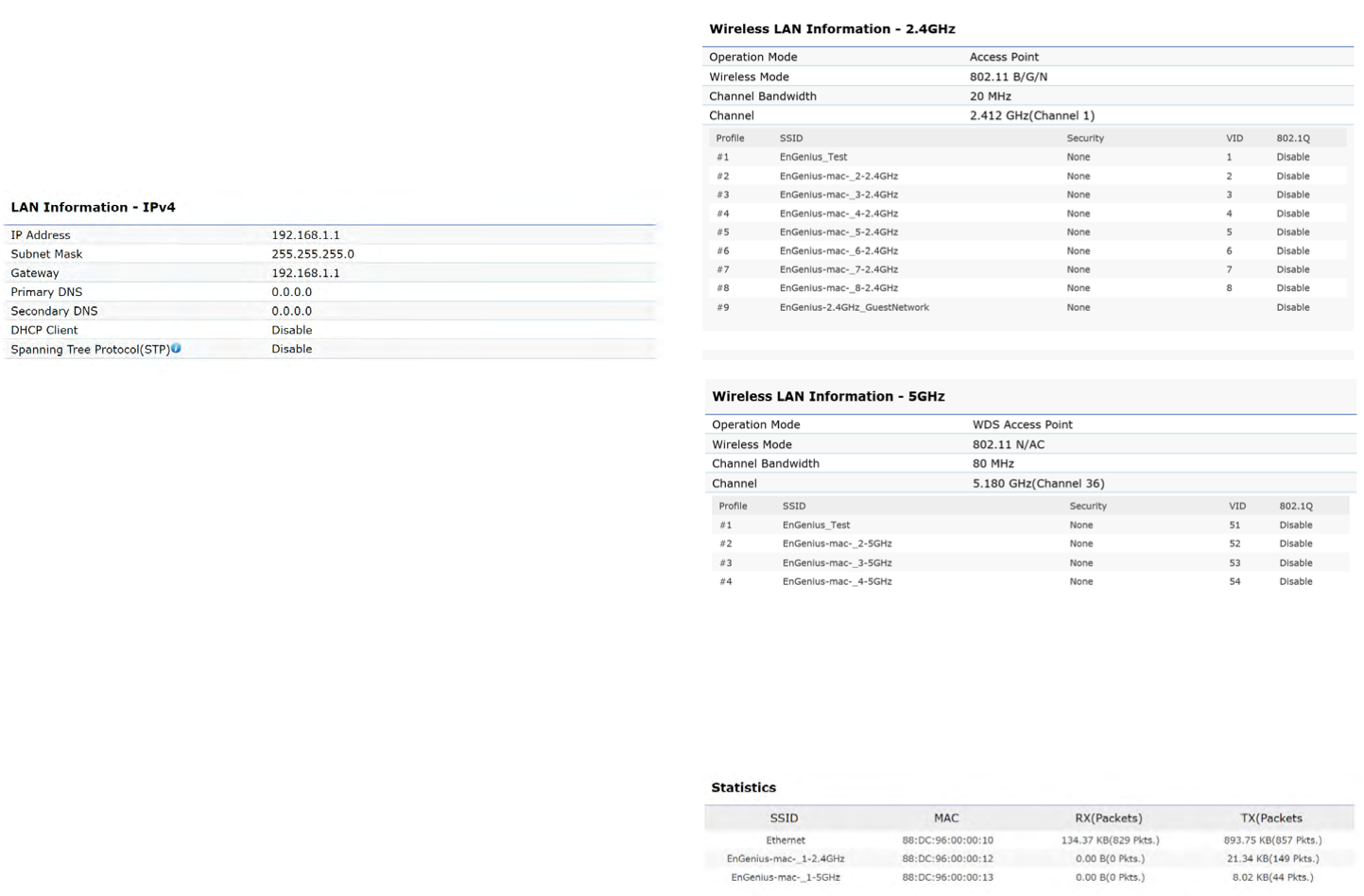
31
• The LAN Information section shows the Local Area
NetworksettingssuchastheLANIPAddress,Subnet
mask, Primary DNS Address, Secondary DNS Address,
status of DHCP client, and status of Spanning Tree
protocol(STP).
The Wireless LAN Information 2.4 GHz/5 GHz section
shows wireless information such as Operation Mode,
Frequency,andChannel.SincethisAccessPointsupports
multiple-SSIDs,informationabouteachSSID,theESSID,
andsecuritysettings,aredisplayed
Note: ProleSettingsareonlyapplicableinAccessPoint
and WDS AP modes.
• TheStatistics section shows Mac information such as
SSID,MACaddress,RXandTX.
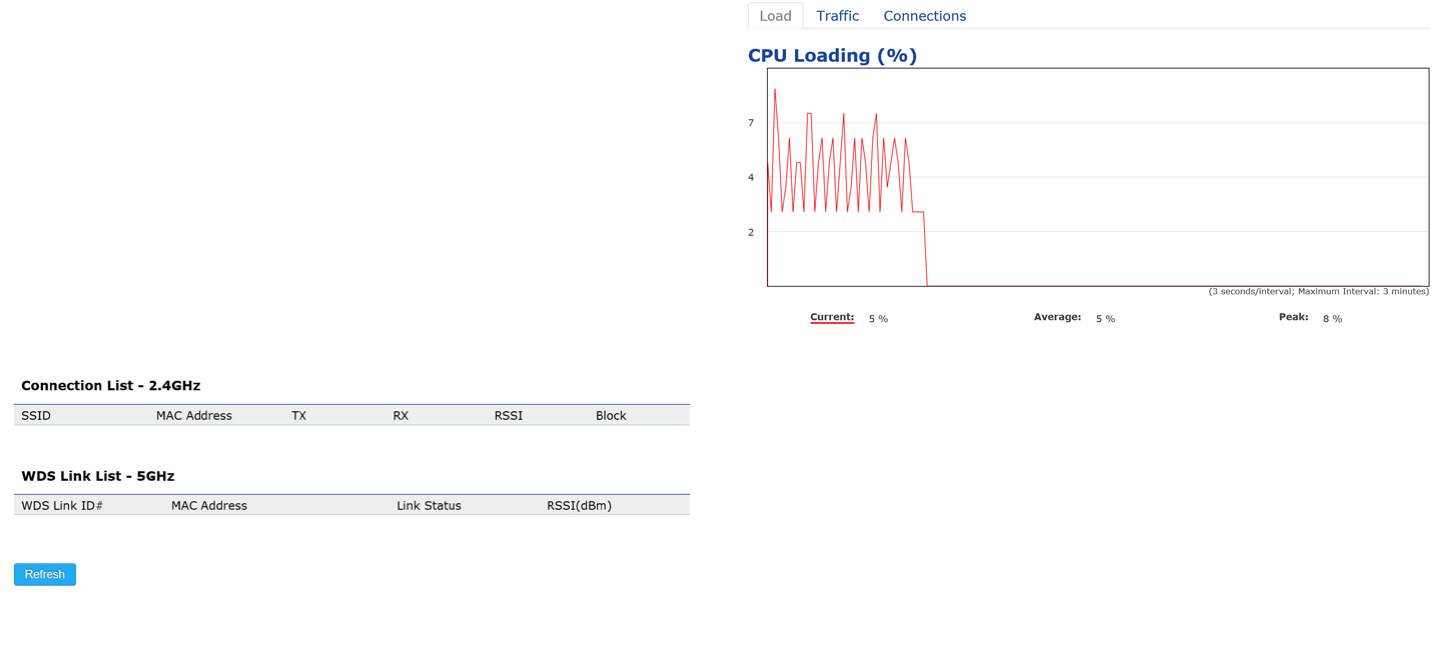
32
2.4 GHz/5 GHz Connection List
Click the connection link under the Overview menu displays
the connection list of clients associated to the AP’s 2.4
GHz/5 GHz, along with the MAC addresses and signal
strength for each client. Clicking Refresh updates the
client list.
Note: Only applicable in Access Point and WDS AP
modes.
2.4 GHz/5 GHz WDS Link List
Click the connection link under the Overview menu. This
pagedisplaysthecurrentstatusoftheWDSlink,including
WDSLinkID,MACAddress,LinkStatusandRSSI.
Note: Only applicable in WDS AP and WDS Bridge modes.
Realtime
TheRealtimesectioncontainsthefollowingoptions:
CPU Loading: 3 minutes CPU loading percentage
information,itdisplayscurrentloading,averageloading
and peak loading status. Left bar is loading percentage;
button is time tracing. Interval is every 3 seconds
Connections Realtime
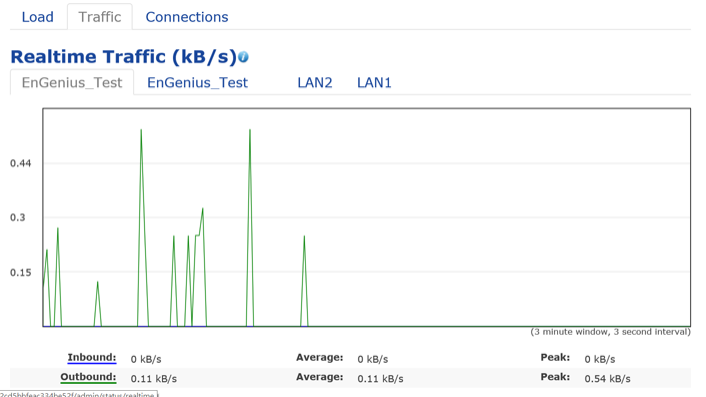
33
Trafc Loading: 2.4GHz and 5GHz and Ethernet port
inboundandoutboundtrafcbycurrent,averageand
peak time.
Realtime Connection (Pkts): Overview on current
active network connections. It displays UDP and TCP
packets information and other connection status. UDP
connections curve is in blue; TCP connection curve is
in green; others curve is in red. Below of chart shows
connections source and destination.
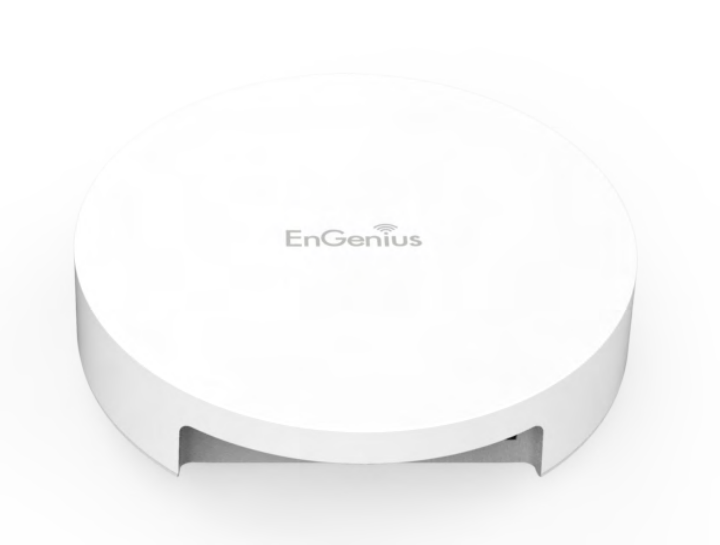
34
Chapter 6
Network
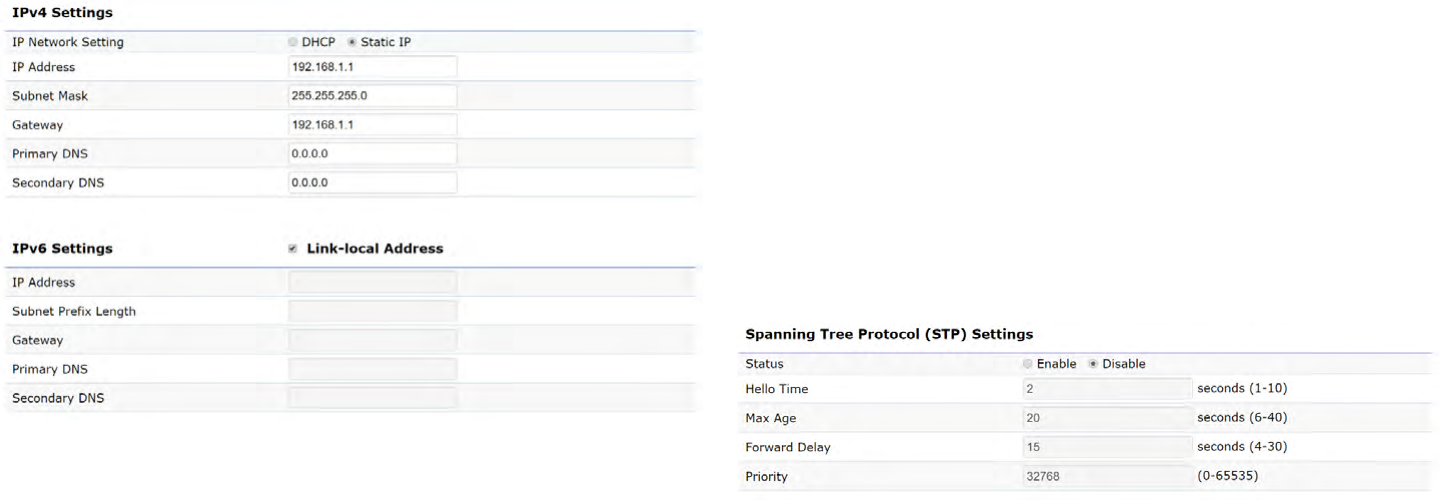
35
IPv4/IPv6 Settings
Thispageallowsyoutomodifythedevice’sIPsettings.
IP Network Settings: Select whether the device IP address
willuseastaticIPaddressspeciedintheIPaddresseld
or be obtained automatically when the device connects to
a DHCP server.
IP Address: The IP address of this device.
Subnet Mask: The IP Subnet mask of this device.
Gateway: The Default Gateway of this device. Leave it
blank if you are unsure of this setting.
Primary/Secondary DNS: The primary/secondary DNS
address for this device.
Save: Click Savetoconrmthechanges.
Spanning Tree Protocol (STP) Settings
This page allows you to modify the Spanning Tree settings.
Enabling the Spanning Tree protocol will prevent network
loops in your LAN network.
Spanning Tree Status:EnablesorDisablestheSpanning
Tree function. Default is Disable.
Hello Time: Species Bridge Hello Time in seconds. This
value determines how often the device sends handshake
packets to communicate information about the topology
throughout the entire Bridged Local Area Network.
Max Age: SpeciesBridgeMaxAgeinseconds.Ifanother
Basic
36
bridge in the spanning tree does not send a hello packet for
alongperiodoftime,itisassumedtobeinactive.
Forward Delay:SpeciesBridgeForwardDelayinseconds.
Forwarding delay time is the time spent in each of the
Listening and Learning states before the Forwarding state
is entered. This delay is provided so that when a new bridge
comesontoabusynetwork,itanalyzesdatatrafcbefore
participating in the network.
Priority: SpeciesthePriorityNumber.Asmallernumber
has a greater priority than a larger number.
Save: Click Savetoconrmthechanges.
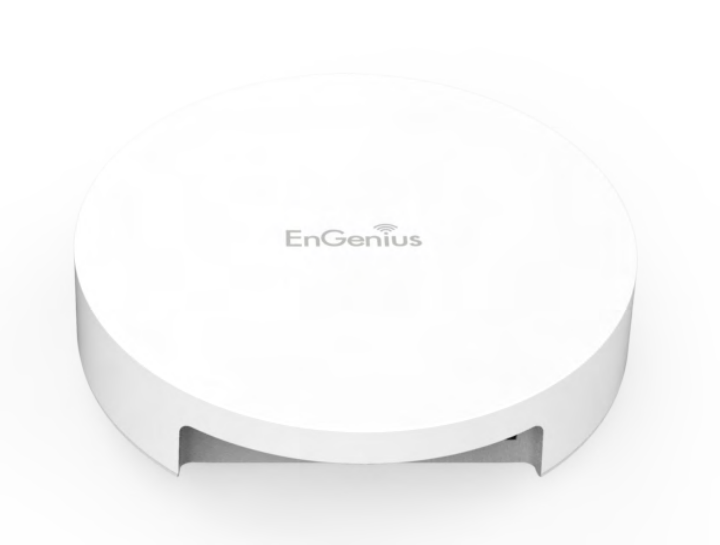
37
Chapter 7
2.4 GHz & 5 GHz Wireless
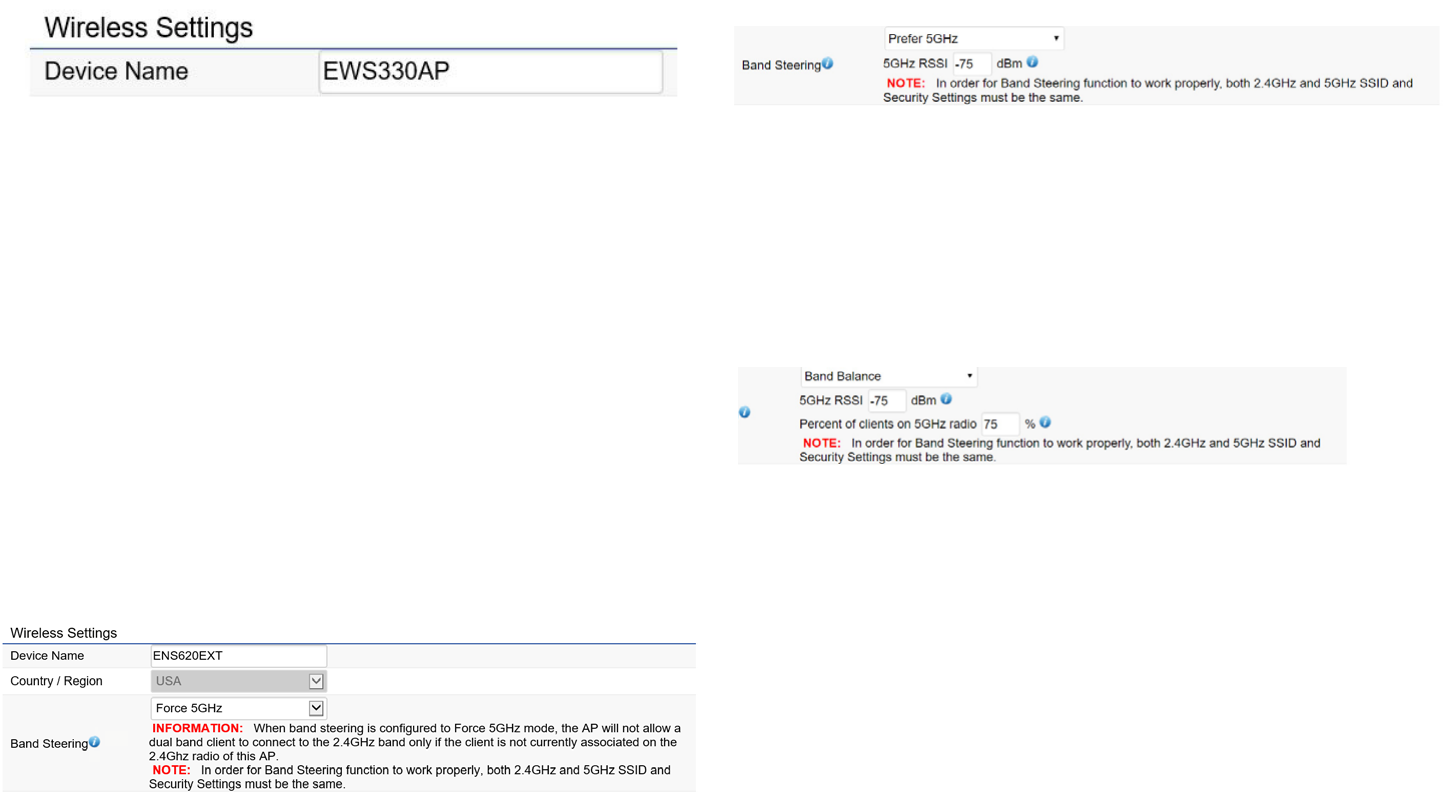
38
Wireless Settings
Device Name: Enter a name for the device. The name you
type appears in SNMP management. This name is not the
SSID and is not broadcast to other devices.
Band Steering (Available on ENS620EXT): Enable Band
Steering to send 802.11n clients to the 5 GHz band,
where802.11b/gclientscannotgo,andleave802.11b/g
clients in 2.4GHz to operate at their slower rates. Before
implementingthisfeature,wesuggestyoutoassurethe
both2.4GHzand5GHzSSID,aswelllassecuritysettings
must be the same. EnGenius Band Steering supports
followingadvancedsettings,
*Force 5GHz:WhenbandsteeringisconguredtoForce
5GHz mode, the AP will not dual band capable client
devices to network to the 2.4GHz band only if the client
devices are not currently associated on 2.4GHz radio in
this AP.
*Prefer 5GHz:WhenbandsteeringisconguredtoPrefer
5GHz mode, the AP will steer dual band capable client
devices to 5GHz radio when the RSSI value of these client
devices on 5GHz radio is more than set one. The allowed
RSSI value for default setting is -75dBm.
*Band Balance: When band steering is congured to
BandBalancemode,theAPwillsteerdualbandcapable
client devices to 5GHz when the RSSI value of these client
devices on 5GHz radio is more than set one. To evenly
allocateRFresourceontheboth2.4GHzand5GHzradios,
users also can set the portion of client devices on 5GHz
radio to assure smoothly connection. The default value of
the5GHzradiois75%.
Save: Click Savetoconrmthechanges.
Wireless

39
This page displays the current status of the Wireless
settings of this AP.
2.4 GHz/5 GHz Wireless Network
Operation Mode: Scrow down this list to select operation
modes for implementing on this radio. The default operation
mode is Access Point on base stations and Access Points
and is Client BridgeonClientPremiseEquipements(CPE).
Meanwhile, EnGenius outdoor devices also support WDS
modes for peer to peer or peer to multi-peer connections.
Wireless Mode: Scrow down this list to select wireless
broadcasting standard on 2.4GHz and 5GHz frequency
bands.
Channel HT Mode: Scrow down this list to select bandwidth
for operating under a frequency band. The default channel
bandwidth is 20 MHz on 2.4GHz frequency radio and 40
MHz on 5GHz frequency radio. Considering the different
applications, users can decide to implement a channel
bandwidthtofulllrealapplications.Thelargerthechannel,
the greater the transmission quality and speed.
Transmit Power (Tx Power):DefaultTxpowerisAuto
to obey regulartory power of each country.
Channel: Click Configuration button to open a new
windows to configure channels for performing wireless
service.
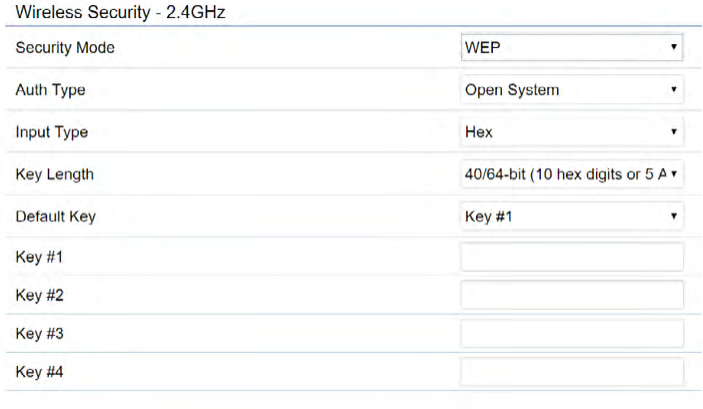
40
Wireless Security
TheWirelessSecuritysectionletsyouconguretheAP’s
security modes
Secuirty Mode: Including WEP, WPA-PSK, WPA2-PSK,
WPA-PSKMixed,WPA,WPA2,andWPAMixed.Westrongly
recommend you to use WPA2-PSK mode.
* Setting of WEP mode:
Auth Type: Select Open System or Shared Key.
Input Type:
ASCII:RegularText(recommended)
HexadecimalNumbers(Foradvancedusers)
Key Length: Select the desired option and ensure that
wirelessclientsusethesamesetting.Yourchoicesare64,
128,and152-bitpasswordlengths.
Default Key: Select the Key you wish to be the default.
Transmitted data is ALWAYS encrypted using the Default
Key; the other Keys are for decryption only. You must enter
a Key Value for the Default Key.
Encryption Key Number: Enter the Key Value or values you
wish to use. Only the Key selected as Default is required.
The others are optional.
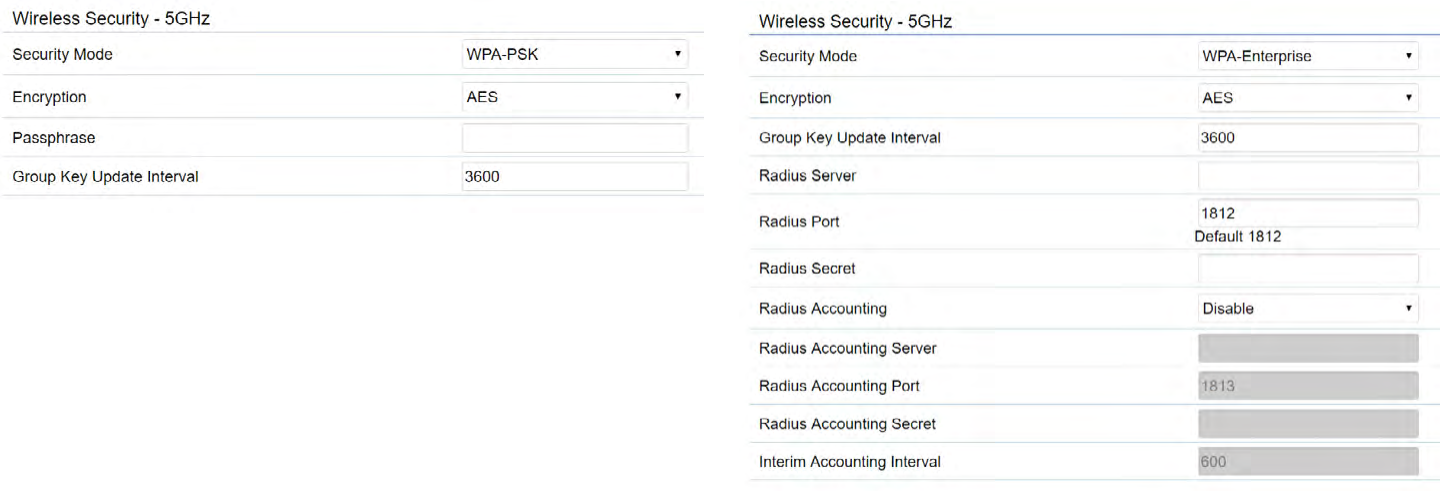
41
* Setting of WPA-PSK, WPA2-PSK and WPA-PSK Mixed
(Pre-Shared Key):
Encryption:YoumayselectAES,TKIPorBoth(TKIP+AES)
to be the encryption type you would like. Please ensure
that your wireless clients use the same settings.
Passphrase: Wireless clients must use the same Key to
associatethedevice.IfusingASCIIformat,theKeymust
befrom8to63charactersinlength.IfusingHEXformat,
theKeymustbe64HEXcharactersinlength.
Group Key Update Interval: Species how often, in
seconds,theGroupKeychanges.Thedefaultvalueis3600.
*
* Setting of WPA-Enterprise & WPA2-Enterprise (Pre-
Shared Key):
Encryption: Select the WPA encryption type you would like.
Please ensure that your wireless clients use the same settings.
Radius Server: Enter the IP address of the Radius server.
Radius Port: Enter the port number used for connections
to the Radius server.
42
Radius Secret: Enter the secret required to connect to the
Radius server.
Radius Accounting: Enable or disable accounting feature.
Radius Accounting Server: Enter the IP address of the
Radius accounting server.
Radius Accounting Port Enter the port number used for
connections to the Radius accounting server.
Radius Accounting Secret: Enter the secret required to
connect to the Radius accounting server.
Interim Accounting Interval: Species how often, in
seconds,theaccountingdatasends.
Note: 802.11n does not allow WEP/WPA-PSK TKIP/
WPA2-PSK TKIP security mode. The connection mode
will automatically change from 802.11n to 802.11g.

43
Wireless Advanced
Wireless Trafc Shaping
Trafc shaping regulates the ow of packets leaving an
interfacetodeliverimprovedQualityofService.
Enable Trafc Shaping:Defaultisdisable.Youmaycheck
thisoptiontoenableWirelessTrafcShapingperSSID.
Download Limit: Speciesthewirelesstransmissionspeed
used for downloading.
Upload Limit: Species the wireless transmission speed
used for uploading.
Per User: Check this option to enable wireless trafc
shaping per user function. This function allow users to limit
themaximumdownload/uploadbandwidthforeachclient
devices on this SSID.
Save: Click Savetoconrmthechanges.

44
Fast Roaming
Enable the function to serve mobile client devices that roam
from Access Point to Access Point. Some applications running
on Client devices require fast re-association when they roam
to a different Access Point
Please enter the settings of the SSID and initialize the Security
modetoWPAenterprise,aswellastosettheRadiusServer
rstly.UserscanenabletheFastRoamingandimplementthe
advanced search.
Please also set the same enterprise Encryption under
the same SSID on other Access Points and enable the
Fast Roaming. When the conguration is realized on
different Access Point, the mobile client devices can run
the voice service and require seamless roaming to prevent
delay in conversation from Access Point to Access Point.
Enable Fast Roaming: Enable or disable fast roaming
feature.
Enable Advanced Search: Enable or disable advanced
search feature.
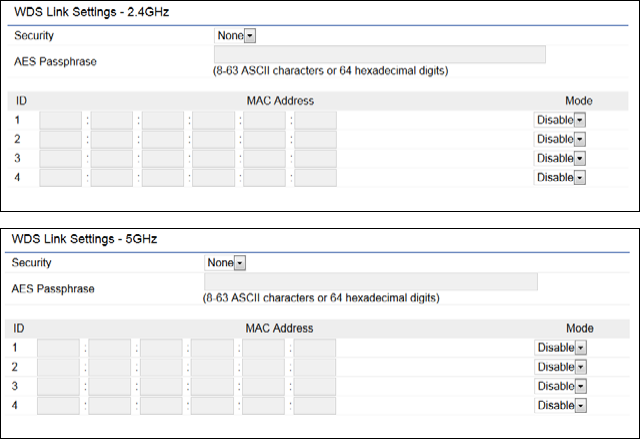
45
WDS Link Settings
UsingtheWDS(WirelessDistributionSystem)featurewill
allow a network administrator or installer to connect to
Access Points wirelessly. Doing so will extend the wired
infrastructure to locations where cabling is not possible or
inefcienttoimplement.
Note: Compatibility between different brands and
models of Access Points is not guaranteed. It is
recommended that the WDS network be created using
thesamemodelsformaximumcompatibility.
Also note: All Access Points in the WDS network need
to use the same Channel and Security settings.
TocreateaWDSnetwork,pleaseentertheMACaddresses
of the Access Points that you want included in the WDS.
TherecanbeamaximumoffourAccessPoints.
Note: Only applicable in WDS AP and WDS Bridge modes.
2.4 GHz/5 GHz WDS Link Settings
Security: Select None or AES from the drop-down list.
AES Passphrase: Enter the Key Values you wish to use.
Other Access Points must use the same Key to establish a
WDS link.
MAC Address: Enter the Access Point’s MAC address to
whereyouwanttoextendthewirelessarea.
Mode:Selecttodisableorenablefromthedrop-downlist.
Save: Click Save toconrmthechanges.
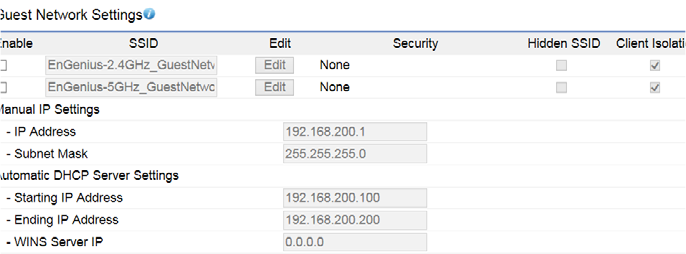
46
Adding a guest network to allow visitors to use the internet
withoutgivingoutyourofceorcompanywirelesssecurity.
You can add a guest network to each wireless network in
the 2.4GHz frequencies and 5GHz frequencies.
SSID: Specied the SSID for the current prole.. Choices
givenare:Disabled,DenyMACinthelist,orAllowMACin
the list.
Hidden SSID: CheckthisoptiontohideSSIDfromclients,If
checked,thisSSIDwillnotappearintheAPdetect.
Client Isolation: Click the appropriate radio button to allow
or prevent communication between client devices.
IP address: The IP Address of this device.
Subnet Mask: The IP Subnet mask of this device.
Starting IP Address: TherstIPAddressintherangeof
the addresses by the DHCP server.
Ending IP Address: The last IP Address in the range of
addresses assigned by the DHCP server.
Guest Network Settings

47
Enable : Enable the Fast Handover feature by ensuring that
each client is served by at least one Access Point at any
time. Access Points continuously monitor the connectivity
quality of any client in their range and efciently share
this information with other Access Points in the vincinity
of that client to coordinate which of them should serve the
client best.
RSSI: Enter the RSSI (Received Signal Strength Index) in
order to determine the handover procedure which the
current wireless link will terminate. RSSI is an indication of
thepowerlevelbeingreceivedbytheantenna.Therefore,
thehighertheRSSInumber,thestrongerthesignal.
RSSI Threshold

48
Wireless MAC Filtering is used to allow or deny network
access to wireless clients (computers, tablet PCs, NAS,
smartphones,etc.)accordingtotheirMACaddresses.You
can manually add a MAC address to restrict permission to
accessEAP1750H.Thedefaultsettingis:Disable Wireless
MAC Filter.
Note: Only applicable in Access Point and WDS AP mode.
ACL (Access Control List) Mode: Determines whether
network access is granted or denied to clients whose MAC
addresses appear in the MAC address table on this page.
Choicesgivenare:Disabled,DenyMACinthelist,orAllow
MAC in the list.
MAC Address: Enter the MAC address of the wireless client
youwishtocongurefor.
Add: Click Add to add the MAC address to the MAC Address
table.
Delete: Deletes the selected entries.
Save: Click Save to apply the changes.
Wireless MAC Filtering
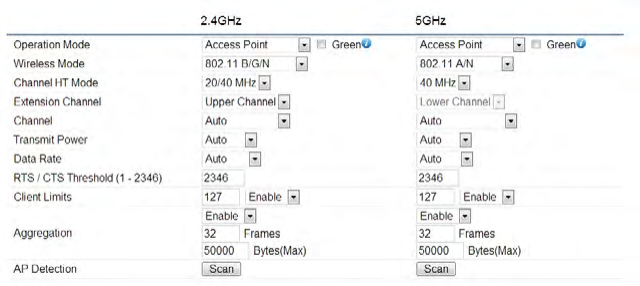
49
This page allows you to congure advanced wireless
settings for the EAP1750H. It is recommended that the
defaultsettingsareusedunlesstheuserhasexperience
with more advanced networking features.
2.4 GHz/5 GHz Wireless Advanced
Data Rate: Select a data rate from the drop-down list. The
data rate affects throughput of data in the EAP1750H.
Thelowerthedatarate,thelowerthethroughput,though
transmission distance will be lowered as well.
Transmit Power: Sets the power output of the wireless
signal.
RTS/CTS Threshold:Speciesthethresholdpackagesize
for RTC/CTS. A smaller number causes RTS/CTS packets to
be sent more often and in turn consumes more bandwidth.
Distance: Species the distance between Access Points
and clients. Longer distances may drop high-speed
connections.
Aggregation: Merges data packets into one packet. This
optionreducesthenumberofpackets,butincreasespacket
sizes.
Save: Click Savetoconrmthechanges.
Wireless Advanced
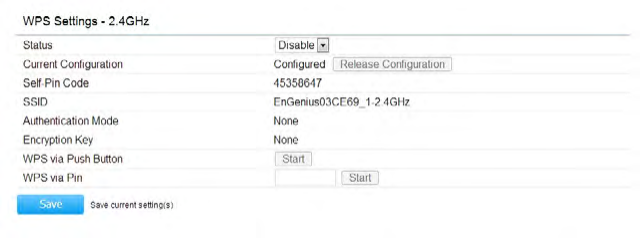
50
TheWi-FiProtectedSetup(WPS)featurecomplieswiththe
Wi-Fi Alliance WPS standard and makes it easier to quickly
addclientdevicestoanestablished,security-enabledWi-Fi
network.
WPSreducestheuserstepsrequiredtocongureanetwork
and supports two methods that are familiar to most
consumerstocongureanetworkandenablesecurity.
Note: Only applicable in Access Point and WDS AP
mode.
WPS (Wi-Fi Protected Setup)
WPS: Select to enable or disable the WPS feature.
WPS Current Status: Shows whether the WPS feature is
Congured or Uncongured. When it is congured, the
WPS has been used to authorize a connection between the
device and wireless clients.
Self Pin Code: The PIN code for this device.
SSID: The SSID (wireless network name) used when
connecting using WPS.
Authentication Mode: Displays the encryption method
used by the WPS process.
Passphrase Key: This is the passphrase key that is randomly
generated during the WPS process. It is required if wireless
clients that do not support WPS attempt to connect to the
wireless network.
WPS via Push Button: Click the Start button to initialize
the WPS feature using the Push Button method.
WPS via PIN: Enter the PIN code for the wireless device
and click this button to initialize WPS feature using the PIN
method.
Save:ClickSavetoconrmthechanges.
WPS (Wi-Fi Protected Setup)

51
Using WDS (Wireless Distribution System) will allow
a network administrator or installer to connect to
Access Points wirelessly. Doing so will extend the wired
infrastructure to locations where cabling is not possible or
inefcienttoimplement.
Note: Compatibility between different brands and
models of Access Points is not guaranteed. It is
recommended that the WDS network be created using
thesamemodelsformaximumcompatibility.
Also Note: All Access Points in the WDS network must
use the same Channel and Security settings.
TocreateaWDSnetwork,pleaseentertheMACaddresses
of the Access Points that you want included in the WDS
network.Therecanbeamaximumoffour(4)AccessPoints.
Note: Only applicable in WDS AP and WDS Bridge modes.
2.4 GHz/5 GHz WDS Link Settings
Security: Select None or AES from the drop-down list.
AES Passphrase: Enter the Key Values you wish to use.
Other Access Points must use the same Key to establish a
WDS link.
MAC Address: Enter the Access Point’s MAC address to
whichyouwanttoextendthewirelessarea.
Mode:SelectDisable or Enable from the drop-down list.
Save: Click Savetoconrmthechanges.
WDS Link Settings
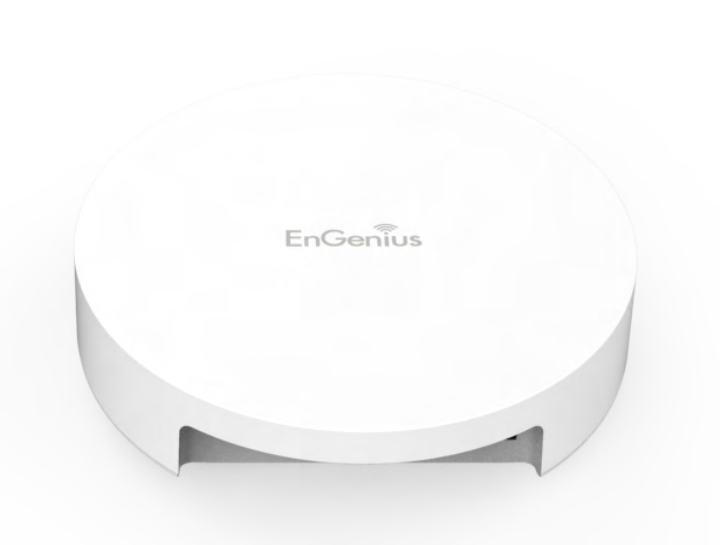
52
Chapter 8
Management

53
Management VLAN Settings
This page allows you to assign a VLAN tag to packets sent
over the network. A VLAN is a group of computers on a
networkwhosesoftwarehasbeenconguredsothatthey
behave as if they were on a separate Local Area Network
(LAN). Computers on VLAN do not have to be physically
locatednexttooneanotherontheLAN.
Note: Only applicable in Access Point and WDS AP
modes.
Management VLAN:IfyournetworkincludesVLANs,you
can enable Management VLAN ID for packets passing
through the Access Point with a tag.
Save: Click SavetoconrmthechangesorCancel to cancel
and return to previous settings.
Note: IfyoureconguretheManagementVLANID,you
may lose your connection to this AP. Verify that the
DHCP server supports the recongured VLAN ID and
then reconnect to this AP using the new IP address.
MGMT VLAN Settings
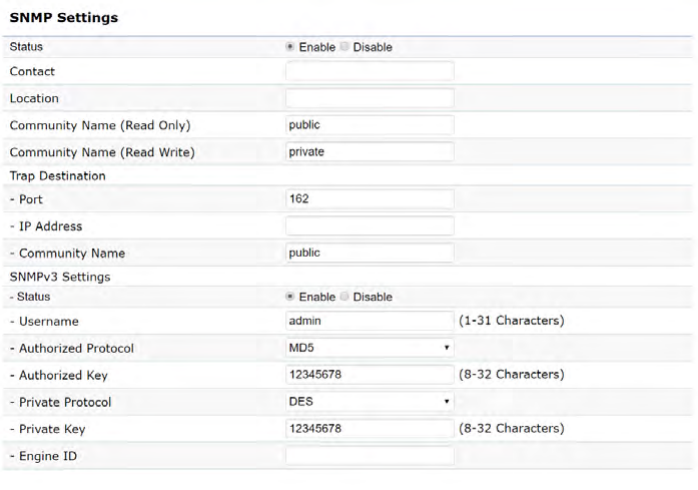
54
SNMP Settings
ThispageallowsyoutoassigntheContactDetails,Location,
CommunityName, and Trap Settings for a Simple Network
Management Protocol (SNMP). SNMP is a networking
management protocol used to monitor network attached
devices.SNMPallowsmessages(calledprotocoldataunits)
to be sent to various parts of the network. Upon receiving
these messages, SNMP compatible devices (called agents)
returns the data stored in their Management Information
Bases.
SNMP Enable/Disable:EnablesordisablestheSNMP
feature.
Contact: Speciesthecontactdetailsofthedevice.
Location: Speciesthelocationofthedevice.
Community Name (Read Only): Speciesthepassword
for the SNMP community for read only access.
Community Name (Read/Write):Speciesthepassword
for the SNMP community with read/write access.
Trap Destination Address:SpeciestheIPaddressofthe
computer that will receive the SNMP traps.
Trap Destination Community Name: Speciesthe
password for the SNMP trap community.
SNMPv3: Enables or disables the SNMPv3 feature.
User Name:SpeciestheusernameforSNMPv3.
Auth Protocol:Selectstheauthenticationprotocoltype:
MDS or SHA.
Auth Key: Speciestheauthenticationkey.
Priv Protocol:Selectstheprivacyprotocoltype:DES.
Priv Key: Speciestheprivacykeyforprivacy.
Advanced Settings
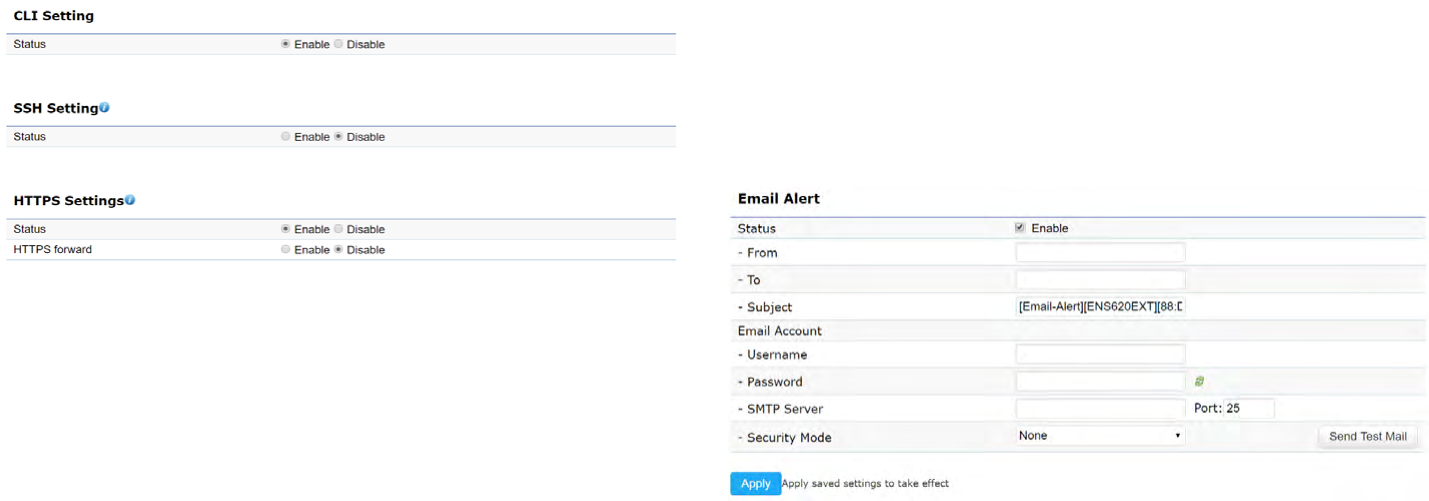
55
Engine ID: SpeciestheengineIDforSNMPv3.
Apply Save: Click Apply Save to apply the changes.
CLI Settings
CLI:TheCommandLineInterface(CLI)allowsyoutotype
commands instead of choosing them from a menu or
selecting an icon.
SSH:EnableSecureShell(SSH)tomakesecure,encrypted
connections in the network. Secure Shell is a network
protocolthatallowsdatatobeexchangedusingasecure
channel between two network devices.
HTTPS: Enable HTTPS to transfer and display web content
securely.TheHypertextTransferProtocoloverSSL(Secure
SocketLayer)isaTCP/IPprotocolusedbywebserversto
transfer and display web content securely.
Email Alert
You can use the Email Alert feature to send messages
to the congured email address when particular system
events occur.
Note:DoNOT use your personal email address as it can
unnecessarilyexposeyourpersonalemaillogincredentials.
Use a separate email account made for this feature instead
Status: Enable this function for further settings.
From: Enter the email address to show the sender of the
email.
To: Enter the address to receive email alerts.
Subject: Enterthetexttoappearintheemailsubjectline.
56
Username: Enter the username for the email account that
will be used to send emails.
Password: Enter the password for the email account that
will be used to send emails.
SMTP Server: Enter the IP address or hostname of the
outgoing SMTP server.
Port: Enter the SMTP port number to use for outbound
emails.
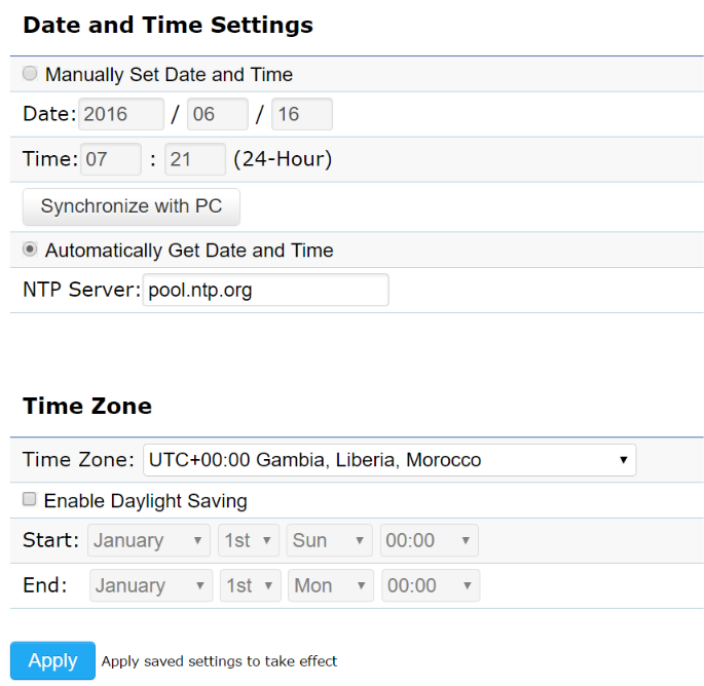
57
Time Setting
This page allows you to set the internal clock of the AP. Manually Set Date and Time: Manually specify the
date and time.
Synchorize with PC:Clickthisbuttontosynchorize
Date and time of this AP with the PC.
Automatically Get Date and Time: Select
Automatically Get Date and Time and check whether
you wish to enter the IP address of an NTP server or
use the default NTP server to have the internal clock
set automatically.
Time Zone: Choose a time zone to implement the
service for this AP.
Enable Daylight Saving:Checkwhetherdaylight
savings applies to your area.
Start:Selecttheday,month,andtimewhendaylight
savings time starts.
Enable Daylight Saving:Selecttheday,month,andtime
when daylight savings times ends.
Time Zone

58
Auto Reboot Settings
You can specify how often you wish to reboot the AP.
Auto Reboot Setting: Enables or disables the Auto
Reboot function.
Timer:Selectthedayandenterthetimeyouwouldlike
to reboot automatically.
Save:ClickSave to apply the changes.
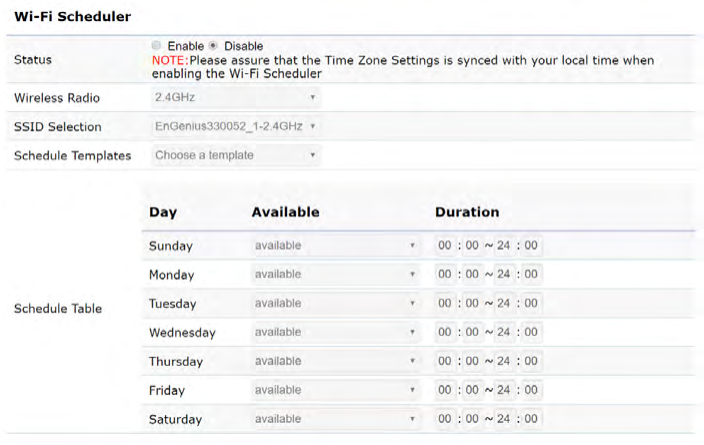
59
Wi-Fi Scheduler
The Wi-Fi Scheduler can be created for use in enforcing
rules. For example, if you wish to restrict web access to
Mon-Fri from 3pm to 8pm, you could create a schedule
selectingMon,Tue,Wed,ThuandFriwhileenteringaStart
time of 3pm and End Time of 8pm to limit access to these
times.
Status: Enables or disables the Wi-Fi scheduler function.
Wireless Radio: Select 2.4 GHz or 5 GHz from the drop-
down list for the preferred band type.
SSID Selection: Select a SSID from the drop-down list.
Schedule Templates: Select a schedule template from the
drop-down list.
Day(s): Placeacheckmarkintheboxesforthedesireddays
or select the All Week radio button to select all seven days
of the week.
Duration:TheStartTimeisenteredintwoelds.Therst
boxisforhoursandthesecondboxisforminutes.TheEnd
Time is entered in the same format as the Start time.
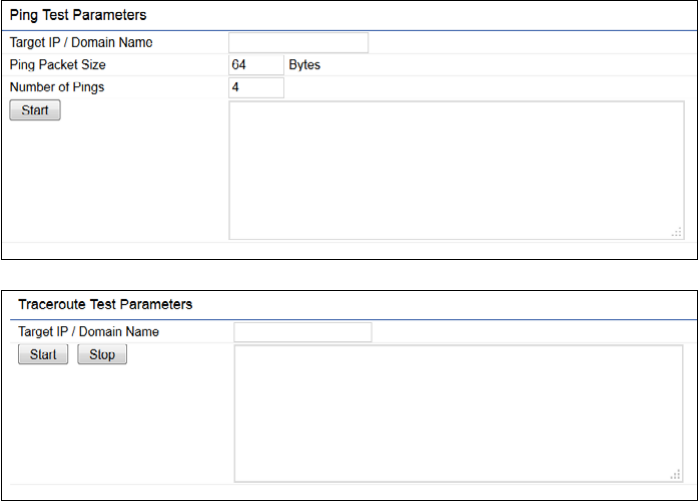
60
Ping Test Parameters
This page allows you to analyze the connection quality
of the AP and trace the routing table to a target in the
network.
Target IP: Enter the IP address you would like to search.
Ping Packet Size: Enter the packet size of each ping.
Number of Pings: Enter the number of times you wish to
ping.
Start Ping: Click Start Ping to begin pinging the target
device(viaIP).
Traceroute Target: Enter the IP address or domain name
you wish to trace.
Start Traceroute: Click Start Traceroute to begin the trace
route operation.
Tools

61
Speed Test Parameters / LED Control
This page allows you to implement speed test to realize
the throughput of a target DUT.
Target IP / Domain Name: Enter an IP address or domain
name you wish to impelement a speed test for realizing
the variance on wireless speed.
Time Period: Enter the time in seconds that you would like
the test to implement for and in how many intervals.
IPv4/IPv6 Port: This Access Points uses IPv4 5001 and
IPv6 5002 port for the speed test.
Start:Clickstarttoimplementspeedtest.
LED Control
ControlLEDon/offforPower,LANinterface,or2.4GHz/5
GHz WLAN interface.
Power: Enables or disables the Power LED indicator.
LAN: Enables or disables the LAN LED indicator.
WLAN-2.4 GHz: Enables or disables the WLAN-2.4 GHz LED
indicator.
WLAN-5 GHz: Enables or disables the WLAN-5 GHz LED
indicator.

62
Device Discovery
This page allows you to discover devices from network
forOperationMode,IPAddress,SystemMACAddressand
Firmware version.

63
This page allows you to change the AP username and
password. By default, the username is: admin and the
passwordis:admin. The password can contain from 0 to
12 alphanumeric characters and is case sensitive.
Account Settings
Administrator Username: Enter a new username for
loggingintotheNewNameentrybox.
Current Password: Enter the old password for logging in
totheOldPasswordentrybox.
New Password: Enter the new password for logging in to
theNewPasswordentrybox.
Verify Password: Re-enter the new password in the
ConrmPasswordentryboxforconrmation.
Apply: Click Apply to apply the changes.
Firmware Upgrade
This page allows you to upgrade the firmware of the
AP.
To Perform the Firmware Upgrade:
1. Click the Choose Filebutton andnavigatethe OSle
systemtothelocationoftheupgradele.
2. Selecttheupgradele.Thenameofthelewillappear
intheUpgradeFileeld.
3. Click the Upload button to commence the rmware
upgrade.
Note: The device is unavailable during the Firmware
upgrade process and must restart when the upgrade is
completed. Any connections to or through the device
will be lost.
Account Firmware
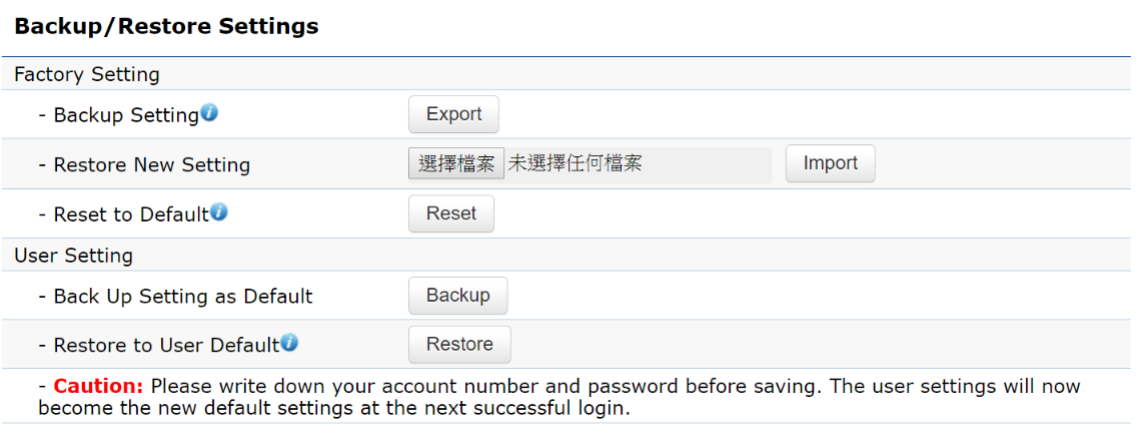
64
Backup/Restore
This page allows you to save the current device
configurations. When you save your configurations,
you also can reload the saved configurations into the
device through the Restore Saved Settings from a file
section.Ifextremeproblemsoccur,orifyouhaveset
theAPincorrectly,youcanusetheReset button in the
Revert to Factory Default Settings section to restore
all the configurations of the AP to the original default
settings.
Backup Setting: Click Export to save the current
configured settings.
Restore New Setting: To restore settings that have
been previously backed up, click Browse, select the
file,andclickRestore.
Restore to Default: Click Reset button to restore the
AP to its factory default settings.

65
User Setting
The function allows you to backup the current device
configurations into the AP as the default value. If
extreme problems occur, or if you have set the AP
incorrectly,youcanpushtheResetbuttontorevertall
the configurations of the AP to the user default.
Back Up Setting as Default: Click Backup to backup
theusersettingsyouwouldliketothedevice’smemory
for the default settings.
Restore to User Default:ClickRestore to restore user
settings to the factory standard settings.
Note1:Aftersettingthecurrentsettingsasthedefault,youshouldclicktheRestore to Default on the
web interface for reverting the settings into the factory default instead of pushing the reset button.
Note2: Please write down your account and password before saving. The user settings will now become
thenewdefaultsettingsatthenextsuccessfullogin.
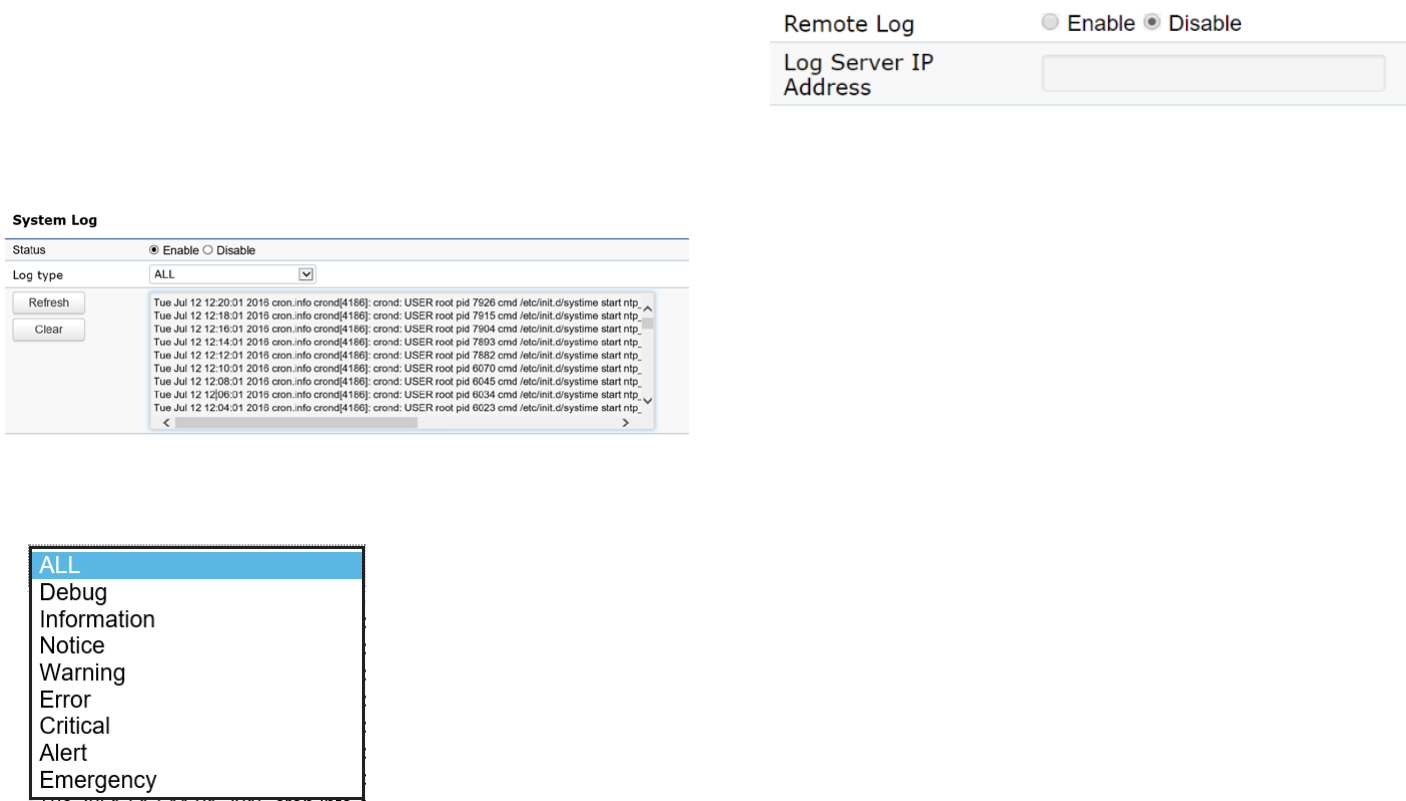
66
System Log
The AP automatically logs (records) events of possible
interest in its internal memory. To view the logged
information,clicktheLog link under the System Manager
menu. If there is not enough internal memory to log all
events, older events are deleted from the log. When
powereddownorrebooted,thelogwillbecleared.
Status:Enable/Disablethisfunction.
Log type: You may choose one of log types to display logs
in the following window. The default log types is All.
Remote Log
This page allows you to setup the Remote Log functions
for this AP.
Remote Log:Enable/Disablethisfunction.
Log Server IP Address: Enter the IP address of the log
server.
Apply: Click Apply to apply the changes.
Log
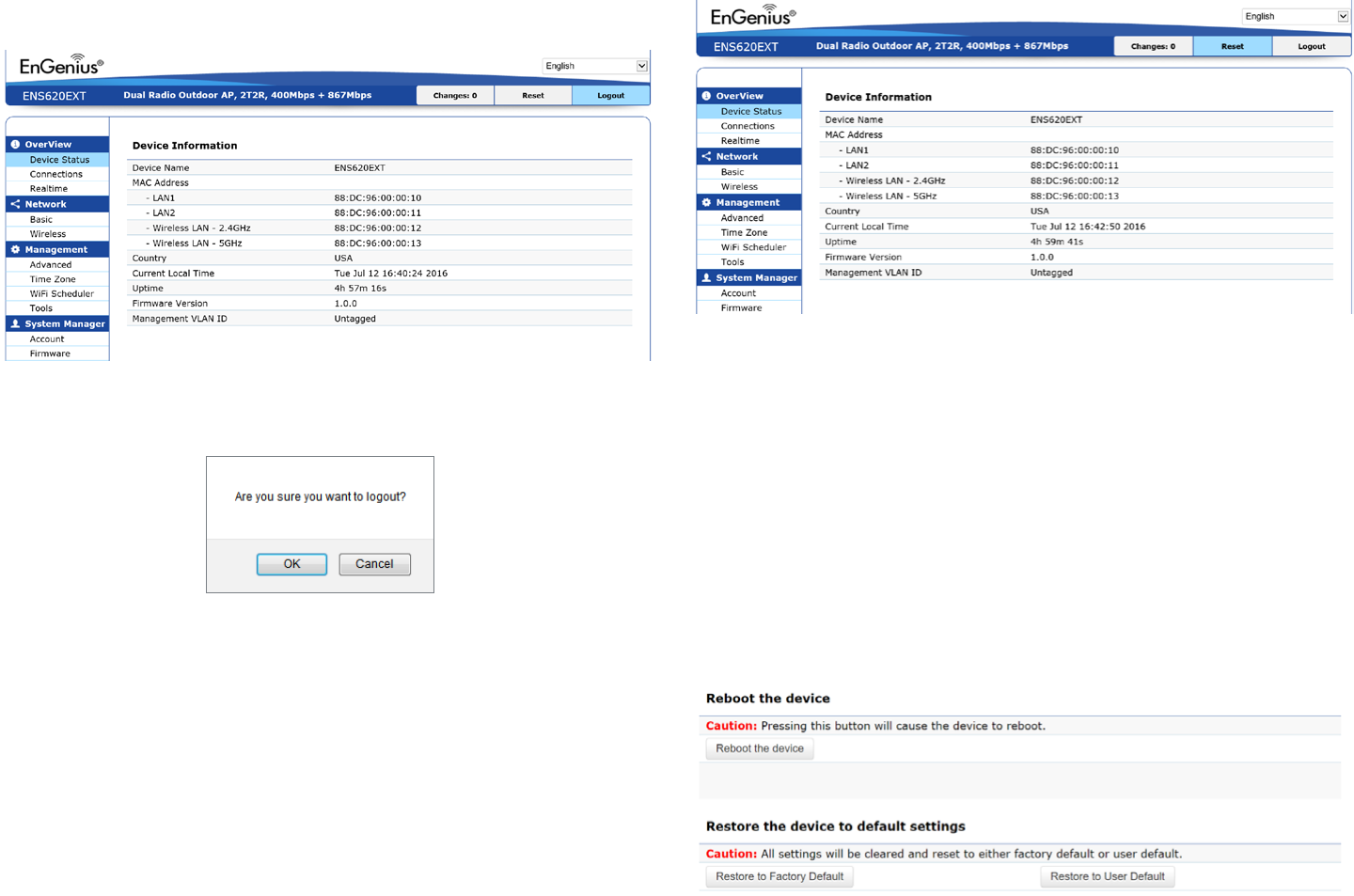
67
Logout
Logout: Click Logout in Management menu to logout.
Pleaseconrmagaintologoutthesystemornot.
Reset
In some circumstances, it may be required to force the
device to reboot. Click on Reset to reboot the AP.
Onceyou click reset button,you will seethe options for
reboot or restore this AP.
Rebootthedevice:Clickittorebootthisdevice.
RestoretoFactoryDefault:Clickittoresetthisdeviceto
factory default setting.
RestoretoUserDefault:Clickittoresetthisdeviceto
userdefaultsettings.Forrealizingthesettingmethod,
you may refer page 66 and page 67.
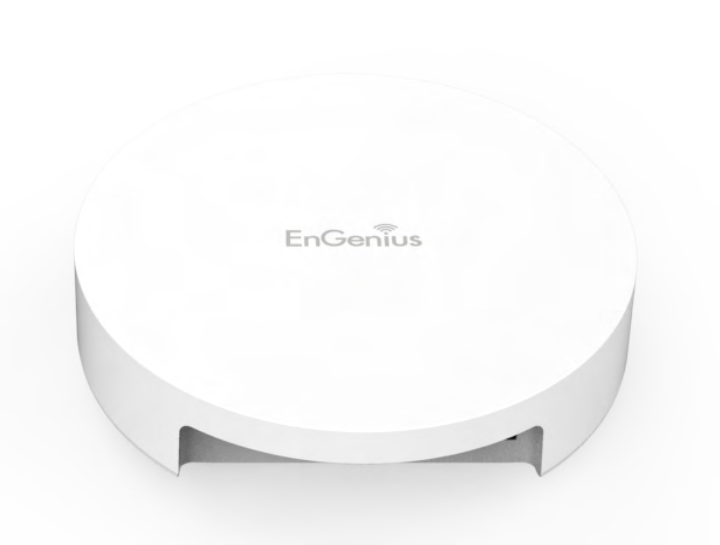
68
Appendix

69
Federal Communication Commission Interference Statement
This equipment has been tested and found to comply with the limits for a Class B digital device, pursuant to Part 15 of the FCC Rules. These limits are
designed to provide reasonable protection against harmful interference in a residential installation. This equipment generates, uses, and can radiate
radio frequency energy and, if not installed and used in accordance with the instructions, may cause harmful interference to radio communications.
However, there is no guarantee that interference will not occur in a particular installation. If this equipment does cause harmful interference to radio
or television reception, which can be determined by turning the equipment o and on, the user is encouraged to try to correct the interference by
one of the following measures:
• Reorientorrelocatethereceivingantenna.
• Increasetheseparationbetweentheequipmentandreceiver.
• Connecttheequipmentintoanoutletonacircuitdierentfromthattowhichthereceiverisconnected.
• Consultthedealeroranexperiencedradio/TVtechnicianforhelp.
FCC Caution:
Any changes or modications not expressly approved by the party responsible for compliance could void the user’s authority to operate
this equipment.
This device complies with Part 15 of the FCC Rules. Operation is subject to the following two conditions: (1) This device may not cause harmful
interference, and (2) this device must accept any interference received, including interference that may cause undesired operation.
IMPORTANT NOTE:
Radiation Exposure Statement
This equipment complies with FCC radiation exposure limits set forth for an uncontrolled environment. This equipment should be installed and
operated with a minimum distance of 20 cm between the radiator & your body.
This transmitter must not be co-located or operating in conjunction with any other antenna or transmitter. Operation of this device is restricted to
indoor use only.
Appendix A

70
Industry Canada Statement
This device complies with RSS-247 of the Industry Canada Rules. Operation is subject to the following two conditions: (1) This device
may not cause harmful interference, and (2) this device must accept any interference received, including interference that may cause
undesired operation.
Ce dispositif est conforme à la norme CNR-247 d’Industrie Canada applicable aux appareils radio exempts de licence. Son fonctionnement
est sujet aux deux conditions suivantes: (1) le dispositif ne doit pas produire de brouillage préjudiciable, et (2) ce dispositif doit accepter
tout brouillage reçu, y compris un brouillage susceptible de provoquer un fonctionnement indésirable.
Caution:
(i) the device for operation in the band 5150-5250 MHz is only for indoor use to reduce the potential for harmful interference to co-
channel mobile satellite systems;
(ii) high-power radars are allocated as primary users (i.e. priority users) of the bands 5250-5350 MHz and 5650-5850 MHz and that these
radarscouldcauseinterferenceand/ordamagetoLE-LANdevices.
(iii) Users should also be advised that high-power radars are allocated as primary users (i.e. priority users) of the bands 5650-5850 MHz
andthattheseradarscouldcauseinterferenceand/ordamagetoLE-LANdevices.
Avertissement:
(i) les dispositifs fonctionnant dans la bande 5150-5250 MHz sont réservés uniquement pour une utilisation à l’intérieur an de réduire
les risques de brouillage préjudiciable aux systèmes de satellites mobiles utilisant les mêmes canaux;
(ii) De plus, les utilisateurs devraient aussi être avisés que les utilisateurs de radars de haute puissance sont désignés utilisateurs
principaux (c.-à-d., qu’ils ont la priorité) pour les bandes 5250-5350 MHz et 5650-5850 MHz et que ces radars pourraient causer du
brouillageet/oudesdommagesauxdispositifsLAN-EL.
(iii) De plus, les utilisateurs devraient aussi être avisés que les utilisateurs de radars de haute puissance sont désignés
utilisateurs principaux (c.-à-d., qu’ils ont la priorité) pour les bandes 5650-5850 MHz et que ces radars pourraient causer du
brouillageet/oudesdommagesauxdispositifsLAN-EL.
Appendix B - IC Interference Statement
71
FOR MOBILE DEVICE USAGE
Radiation Exposure Statement
This equipment complies with IC radiation exposure limits set forth for an uncontrolled environment. This equipment should be installed and operated
with a minimum distance of 20cm between the radiator & your body.
Pour l’utilisation de dispositifs mobiles)
Déclaration d’exposition aux radiations:
Cet équipement est conforme aux limites d’exposition aux rayonnements IC établies pour un environnement non contrôlé. Cet équipement doit
être installé et utilisé avec un minimum de 20cm de distance entre la source de rayonnement et votre corps.
72
Europe – EU Declaration of Conformity
ThisdevicecomplieswithDirective2014/53/EUissuedbytheCommissionoftheEuropeanCommunity.
- Declaration of Conformity
Please added certication standard in your user manual which depended on the test standards your device performed. or
- If the DoC should be a simplied version, please take below as reference –
Hereby,EnGeniusNetworksdeclaresthattheEAP1750H/EAP1300/EAP1300EXT/EAP1250areincompliancewithDirective2014/53/EU.
The full text of the EU declaration of conformity is available at the following internet address:
Importer:EnGeniusNetworksEuropeB.V.
Importer Address: ESP 240, 5633 AC Eindhoven, The Netherlands
Manufacturer : EnGenius Networks. Inc.
Manufacturer Address: No.500, Fusing 3rd Rd., Hwa-Ya Technology Park Kuei-Shan Dist., Taoyuan City, Taiwan (R.O.C.)
CEDoCLink:https://www.engeniusnetworks.eu/ens500ext-ac-ens500-ac-enstation5-accedoc
Appendix C - CE Interference Statement

73
Thisradiotransmitter(IC:10103A-EAP1300/Model:EAP1300/EAP1300EXT)hasbeenapprovedbyISEDtooperatewiththeantennatypelisted
below with maximum permissible gain indicated. Antenna types not included in this list, having a gain greater than the maximum gain indicated
for that type, are strictly prohibited for use with this device.
Le présent émetteur radio (IC: 10103A-EAP1300 / Model: EAP1300/EAP1300EXT) a été approuvé par ISED pour fonctionner avec les types
d’antenneénumérésci-dessousetayantungainadmissiblemaximal.Lestypesd’antennenoninclusdanscetteliste,etdontlegainestsupérieur
au gain maximal indiqué, sont strictement interdits pour l’exploitation de l’émetteur.
Appendix D - DETACHABLE ANTENNA USAGE